NO’AGE concentré Presents A Selection of Tea Cocktails and Pairings That Express Japan’s Seasonal Beauty【Shizuoka City, Shizuoka Prefecture】
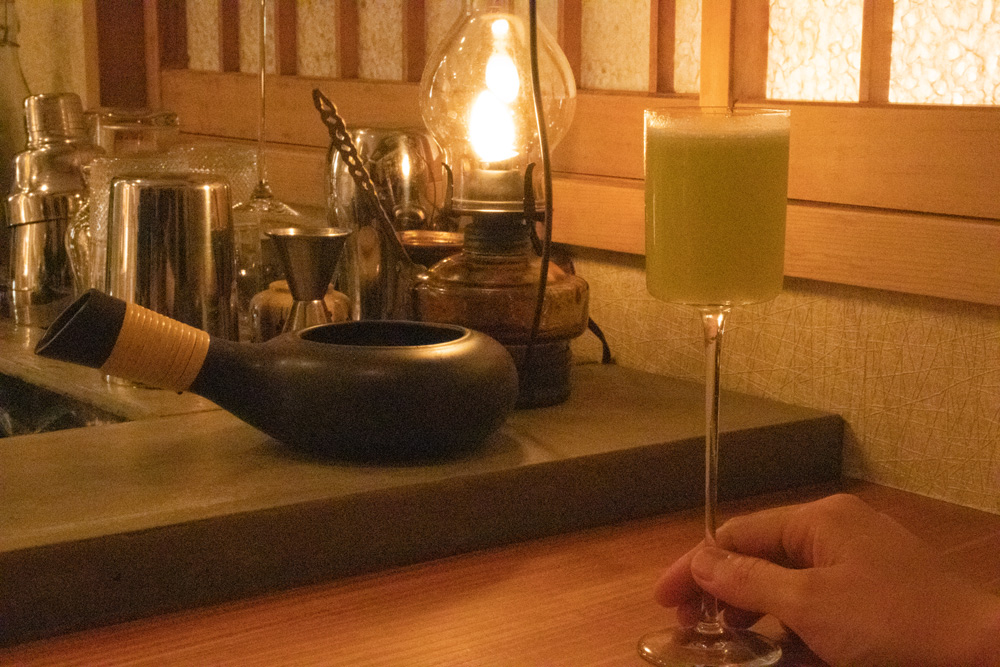
Pairing is a style of dining in which a dish is accompanied by the most compatible drink and enjoyed together. Originally used to pair food and wine, it has recently become popular as a style of pairing dishes with Japanese tea, and is recognized as a promising new way for individuals who do not drink alcohol to enjoy an evening out. We interviewed the owner of NO’AGE concentré, a bar offering pairings of cuisine with Japanese tea and a variety of cocktails. Owner-bartender Itani Masamichi won the Grand Prix in a cocktail competition and is featured in numerous cocktail books. Many people from Japan and abroad visit the restaurant to enjoy the enticing tea cocktails and pairings created by Mr. Itani.
In this article, we report on NO’AGE concentré’s menu and what Mr. Itani considers to be at the heart of his tea cocktails and pairings in an interview.
Contents
- 1 About NO’AGE concentré
- 2 An Introduction to NO’AGE concentré’s Menu
- 3 Interview: NO’AGE concentré, a new species of bar with the unmistakable features of a traditional Japanese saryo (teahouse).
- 3.1 NO’AGE concentré: the vision behind the name
- 3.2 Sublime Japanese tea cocktails and pairings crafted by the Yokohama International Cocktail Competition Grand Prix winner.
- 3.3 The background to his entry into the world of tea; skills and experience accumulated from his career as a bartender.
- 3.4 Concept: A bar providing a luxurious experience to rival those of Kyoto and Tokyo.
- 3.5 Bartender Masamichi Itani’s perspective – the point where a designer’s role and artist’s sensibility intersect.
- 3.6 Japanese Tea Cocktails and Pairings on theme of Japanese Seasonal Beauty~Kachō fūgetsu~
- 4 Information of NO’AGE concentré
About NO’AGE concentré
NO’AGE concentré opened in May 2021 in Takajo, Shizuoka City by owner-bartender, Itani Masamichi. In addition to cocktails full of originality, customers can enjoy pairing Shizuoka tea cocktails with creative dishes and sweets.
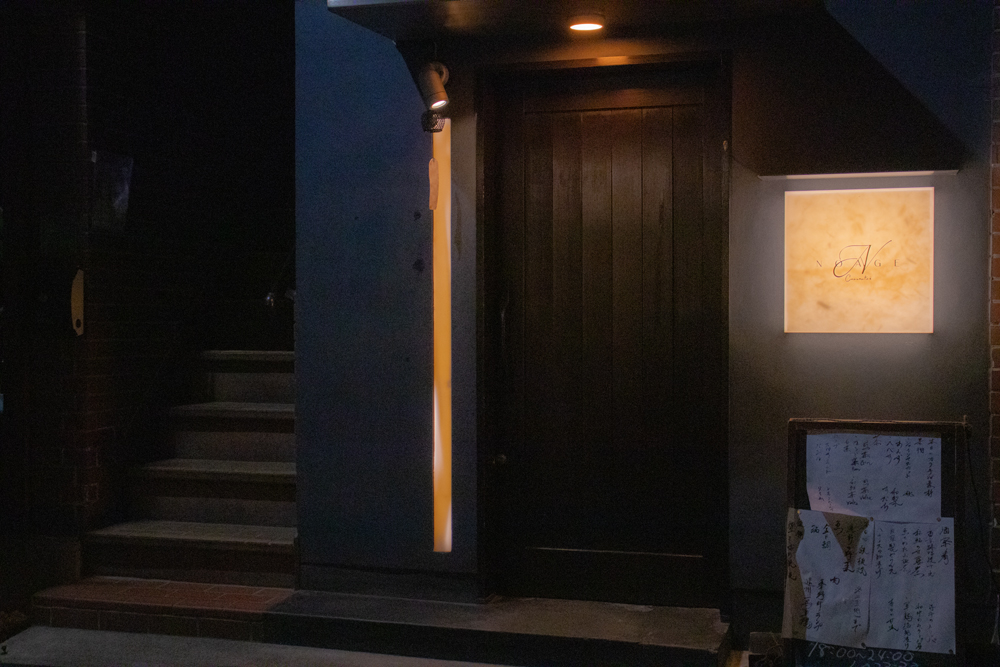 ▲At dusk, on a street corner in a quiet residential area, the door to NO’AGE concentré, with a pale glow, emerges as if it were a counterpart to the darkening sky.
▲At dusk, on a street corner in a quiet residential area, the door to NO’AGE concentré, with a pale glow, emerges as if it were a counterpart to the darkening sky.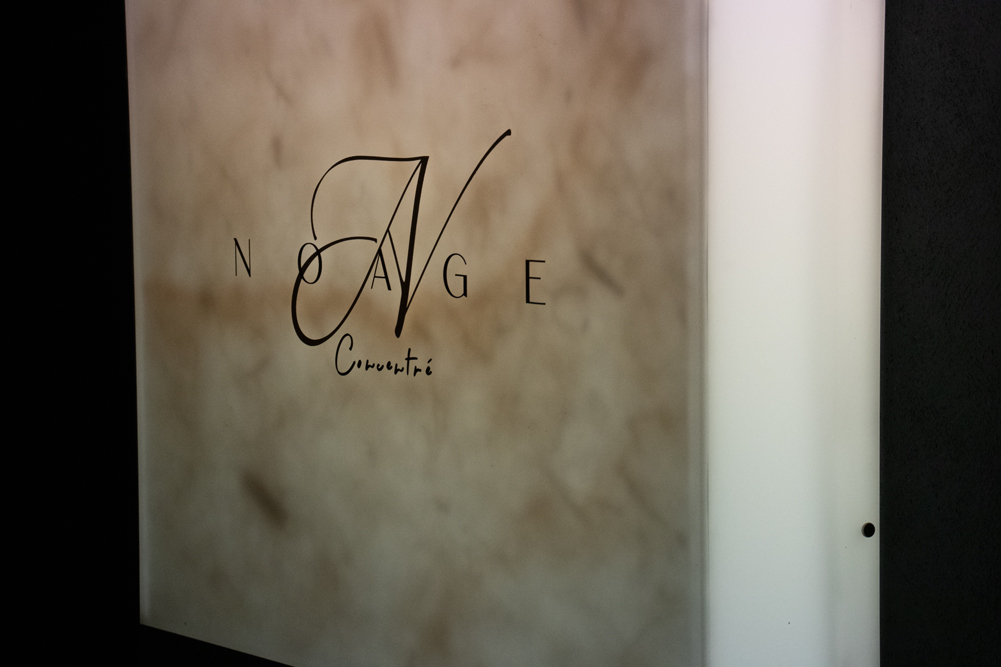 ▲Itani’s design of NO’AGE concentré’s logo. The French word “concentré,” meaning “concentrated” was added to the name of the store to mark the beginning of a new chapter in the company’s history.
▲Itani’s design of NO’AGE concentré’s logo. The French word “concentré,” meaning “concentrated” was added to the name of the store to mark the beginning of a new chapter in the company’s history.
The restaurant has six counter seats facing the griddle and chagama (teapot). The luxurious modern Japanese style interior makes you feel as if you are in a prestigious part of Tokyo or Kyoto, while still being in Shizuoka. Comfortable music plays in the background, reflecting Mr. Itani’s desire to provide a space to enjoy once-in-a-lifetime moments for his guests.
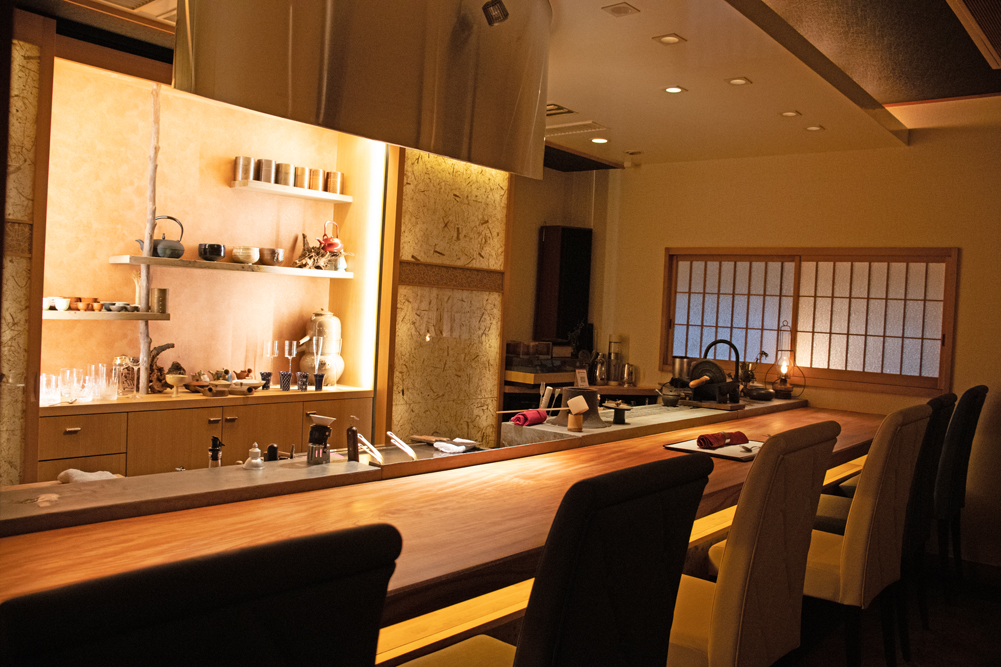
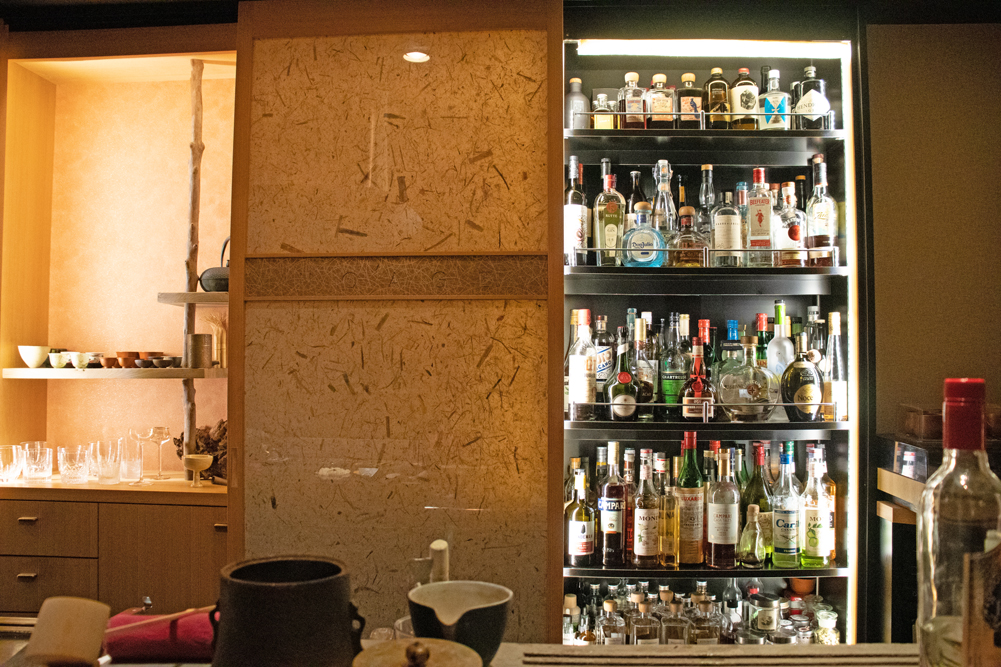 ▲Behind the counter, a wide selection of alcoholic beverages carefully selected by Itani over his career of more than 20 years.
▲Behind the counter, a wide selection of alcoholic beverages carefully selected by Itani over his career of more than 20 years.
An Introduction to NO’AGE concentré’s Menu
Mr Itani’s cocktails range in wide variety from the classics to original concoctions flavored with seasonal fruits. On top of that, “tea” has been added to the mix, allowing customers to enjoy a familiar and profound yet altogether new dimension of “tea cocktails,” paired with a variety of creative dishes.

Here are some of Itani’s original tea cocktails and cuisine that can only be found at NO’AGE concentré. We will focus on tea-based cocktails, but Mr. Itani would like to reassure customers that he is flexible to suit their tastes. *Please note that the menu listed may not be available due to seasonal changes in the menu offerings.
Gyokuro Martini
This tea cocktail is made with gyokuro from Shizuoka, carefully selected by Mr. Itani. The first brew is a careful infusion of gyokuro tea at low temperature. Enjoy the full-bodied aroma and umami of only the finest sencha gyokuro. The second infusion is the tea cocktail “Gyokuro Martini”, in which the deep flavor of the exquisite fusion of gyokuro and sake is realized for your enjoyment.
Mr. Itani isn’t just particular about the quality of his sake, he is also committed to the quality of his tea. For this reason, the gyokuro he serves often varies from day to day, offering the unique experience of different flavors of this prized beverage. For an additional fee, you can also enjoy gyokuro extracted with japanese sake.
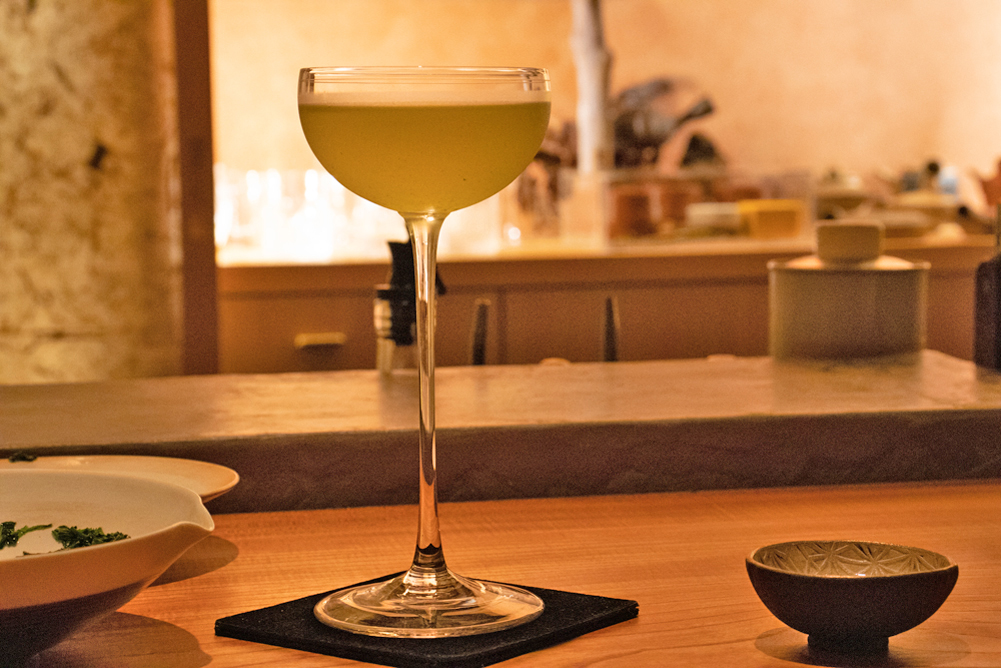
Tsukishiro Martini
Hakuyoucha (white leaf tea) contains three times as much amino acid content as ordinary tea and offers a rich flavor and refreshing sweetness. Its production process, time-consuming and labor-intensive, results in a minimal harvest, earning it a reputation as a rare and precious tea.
In the first infusion, enjoy the true taste of hakuyoucha brewed at low temperature. In the second, the tea is first brewed with vodka and mixed with japanese sake to create a truly original tea cocktail. For an additional fee, you can also enjoy white leaf tea brewed with japanese sake.
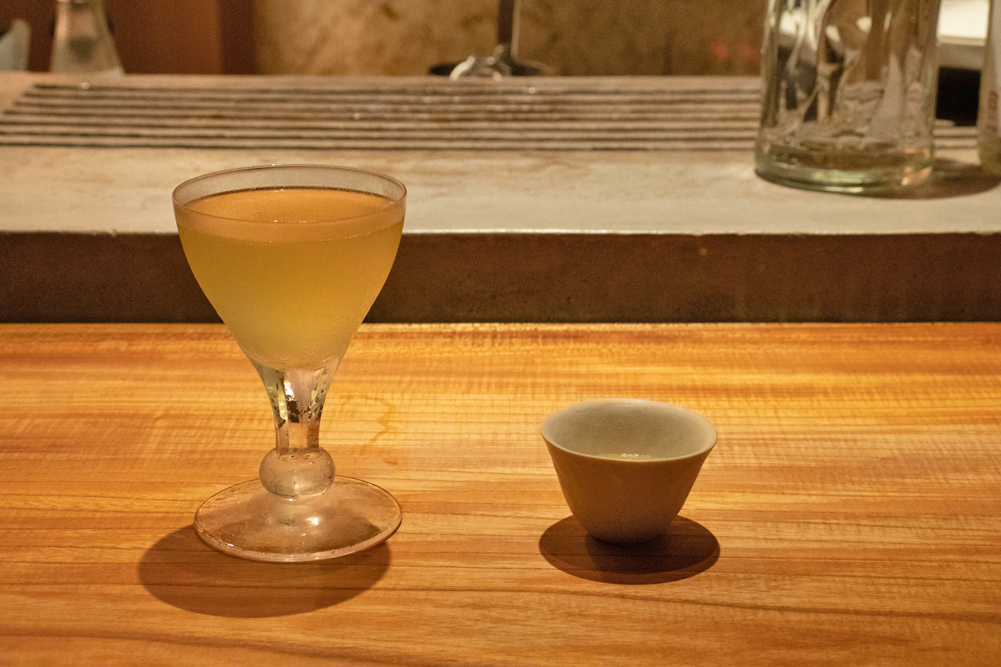 ▲The inspiration for this tea cocktail was the colours of the white moon seen from a tea plantation at the foot of Houta Mountain, one of the three mountains of Enshu.
▲The inspiration for this tea cocktail was the colours of the white moon seen from a tea plantation at the foot of Houta Mountain, one of the three mountains of Enshu.
The hakuyoucha used in the tea cocktail is called “Tsukishiro,” a tea produced with great care by Anma Seicha in Fukuroi, western Shizuoka Prefecture. Mr. Anma and Mr. Itani share Fukuroi as their hometown, where they attended the same school. Due to this close relationship, this collaboration to provide the prized “Tsukishiro” in tea cocktail form was made possible.
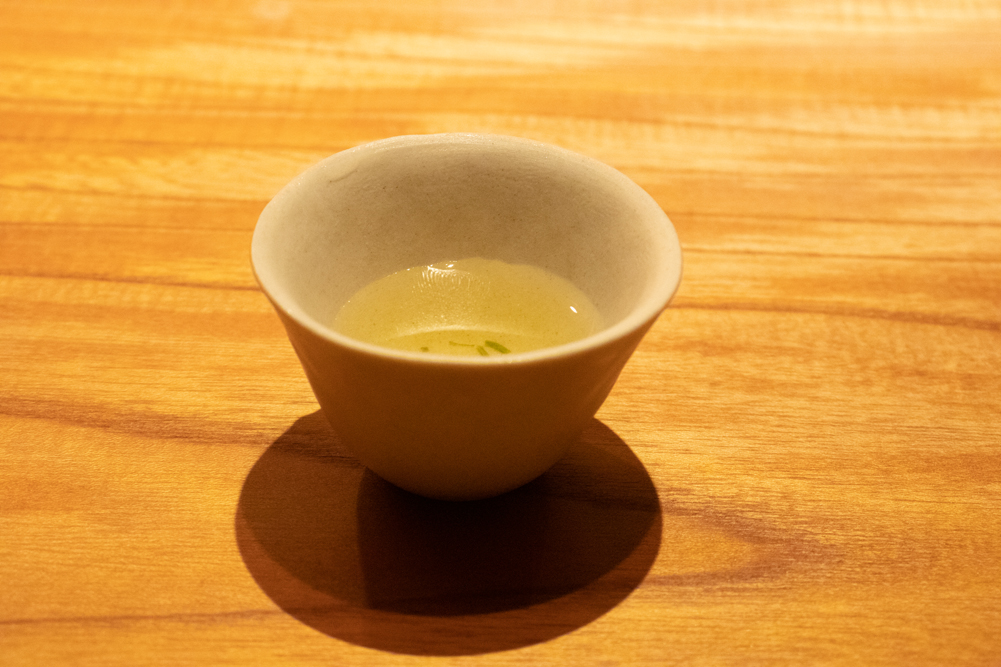 ▲As the name hakuyoucha (white leaf tea) suggests, the tea leaves have a yellowish-white colour, and when brewed, the water is a clear, beautiful golden hue.
▲As the name hakuyoucha (white leaf tea) suggests, the tea leaves have a yellowish-white colour, and when brewed, the water is a clear, beautiful golden hue.
Hojicha with Nectarine and Coconut
This tea cocktail is a perfect blend of the savory and fruity flavors of hojicha. The addition of nectarine and coconut further enhances its natural character.
For this cocktail, Mr. Itani uses nectarines seasoned with vanilla and granulated sugar baked in the oven. The outcome is a concoction “if poured into a gelato machine, would be a fantastic ice cream.” Indeed, this drinkable dessert is a delicious and novel sensation.
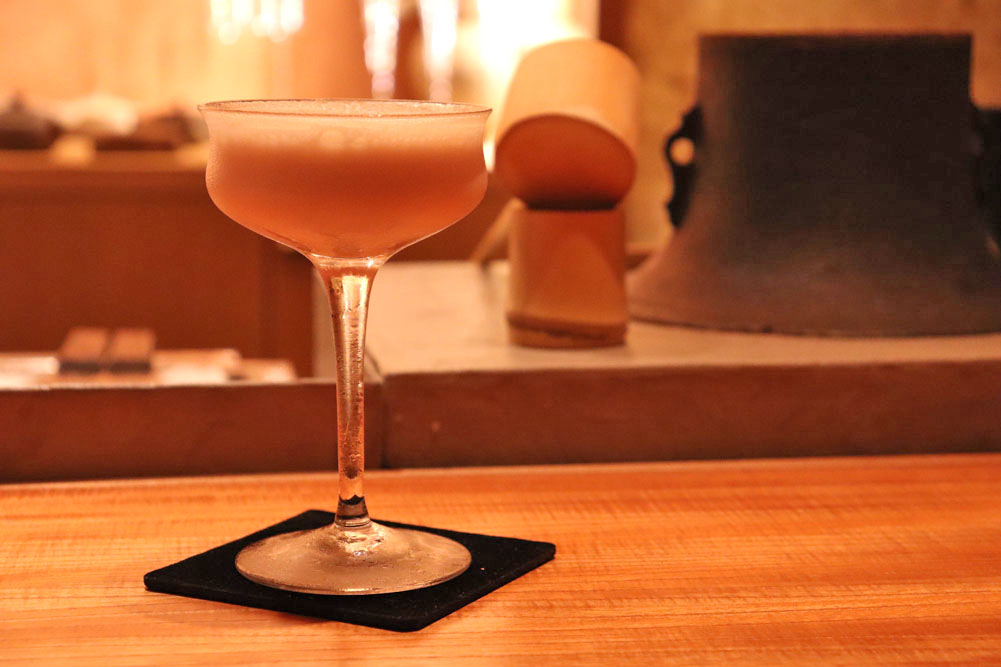
Sencha Gin, Basil and Pear
The sencha used is “Haruna 29,” a variety of tea grown by Houkouen, a tea farm in Ryokouchi, Shimizu. “Haruna 29″ has a well-balanced umami and shibumi flavor, which Itani found to be a good match for the basil.
Adding gin and pears to the mix allows the ingredients to link and harmonize with each other, creating a tea cocktail that is both refreshing and with depth.
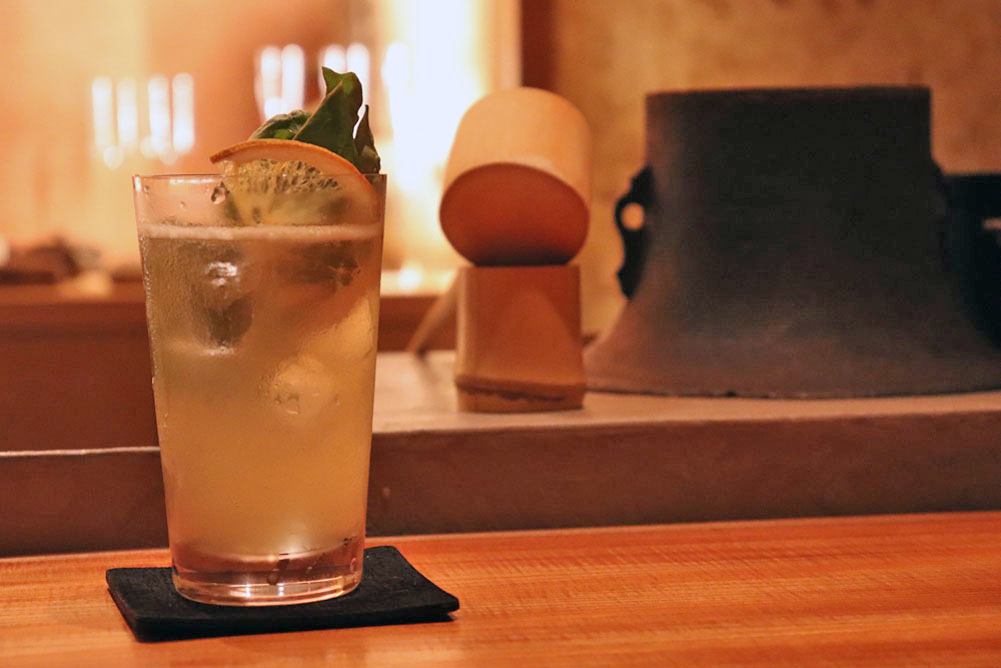 ▲Itani’s inspiration for this cocktail came from the image of Ryokochi’s tea fields bathed in mist glowing in the moonlight.
▲Itani’s inspiration for this cocktail came from the image of Ryokochi’s tea fields bathed in mist glowing in the moonlight.
Myoga, lychee and Jasmine tea
In this tea cocktail, Itani uses a jasmine tea with a special aromatic component, lychee aroma, and adds to that the perfect match, myoga. This combination out each of their unique characteristics in a harmonious fashion.
The fragrance of myoga brings a herbal flavor to the drink, making it a popular classic perfect for early summer.
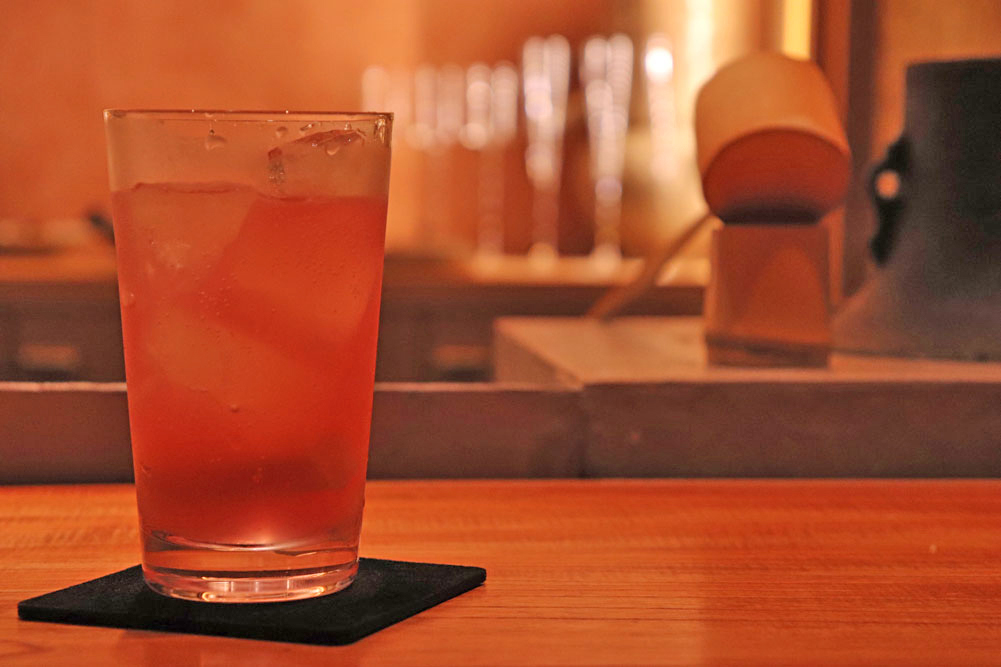
Jasmine Tea Campari Soda
This is a sparkling cocktail consisting of jasmine tea soaked in Mr. Itani’s special blend of Campari. Campari is made from bitter orange and various medicinal herbs and has been used as a treatment for stomach problems in its region of origin. Jasmine tea, on the other hand, is a type of Chinese tea and is also known for its medicinal properties in Asian cultures.
The combination of Campari and jasmine tea is not only delicious, but also has the added benefit of working as an aperitif. This combination has been a cocktail menu staple for a long time and is widely loved by many people.

Hojicha Dark Rum Manhattan
In his unique twist on the “Queen of Cocktails,” The Manhattan, Mr. Itani has taken this traditional recipe and arranged a composition that accentuates the aroma of hojicha and berries (according to him, hojicha has not only a sweet flavor but also an acidic, berry-like element).
This tea cocktail offers a unique taste experience, blending the deep flavor of hojicha with the fruitiness of berries in perfect proportion.
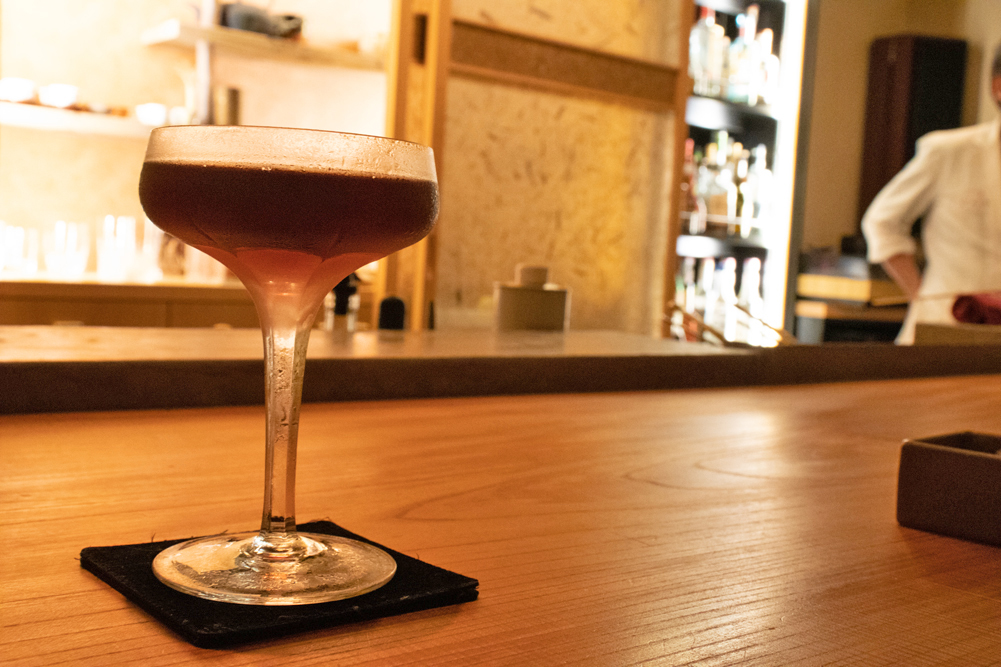
Smoked Black Tea and Potato Shochu Negroni
This tea cocktail was developed by soaking smoked black tea from Kaneroku Matsumoto-en in sweet potato shochu. Inspired by mezcal, a Mexican distilled liquor known for its smoky flavor, Itani used the Negroni as a base on which to further deepen the mood of this tasty drink.
The Negroni is an Italian-born cocktail characterized by the refreshing sharpness of gin, the bitterness of Campari, and the deep sweetness of vermouth garnished with a slice of orange peel.
This new tea cocktail is a sublime combination of smoked black tea, potato shochu and Negroni and it will tempt you to order it over and over again.
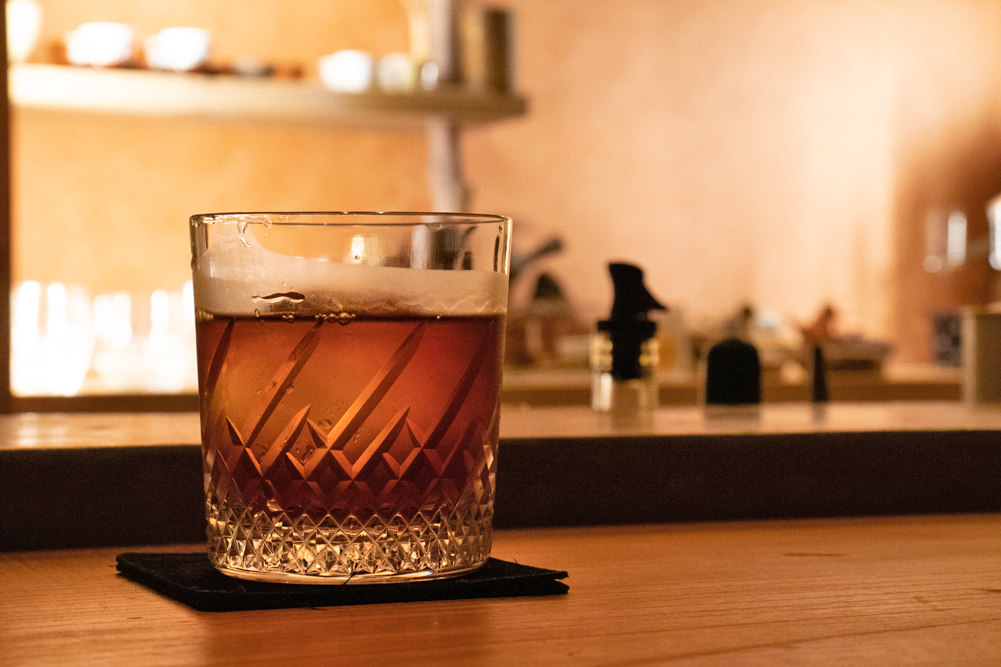
Hojicha Armagnac
This tea cocktail combines the savory and berry notes of “Marubi”, a hojicha from Fuji Marumo Tea Garden, with an aged Armagnac (a brandy made in the Armagnac region of France) displaying notes of black grape.
This cocktail was born out of Itani’s wish for people to “simply savor the aroma of tea,” with notes of oak and wood, as well as a chilli pepperiness to finish.
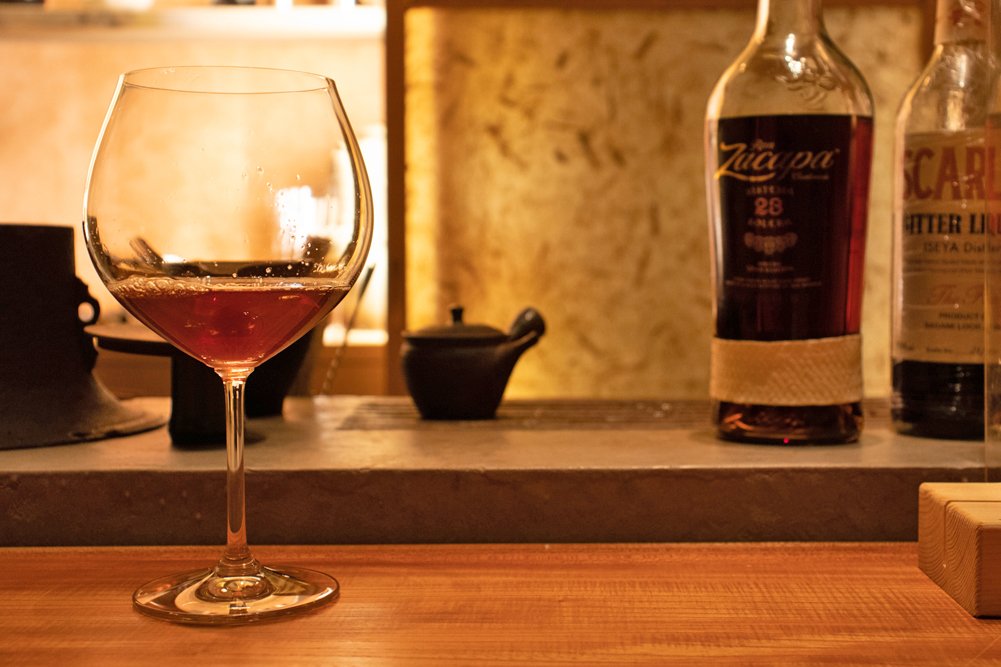
In addition, a variety of other plans are available, including dinner, food, seasonal sweets, cocktails, mocktails and bartime after 9:00 p.m. For more information, please visit the NO’AGE concentré website.

Interview: NO’AGE concentré, a new species of bar with the unmistakable features of a traditional Japanese saryo (teahouse).
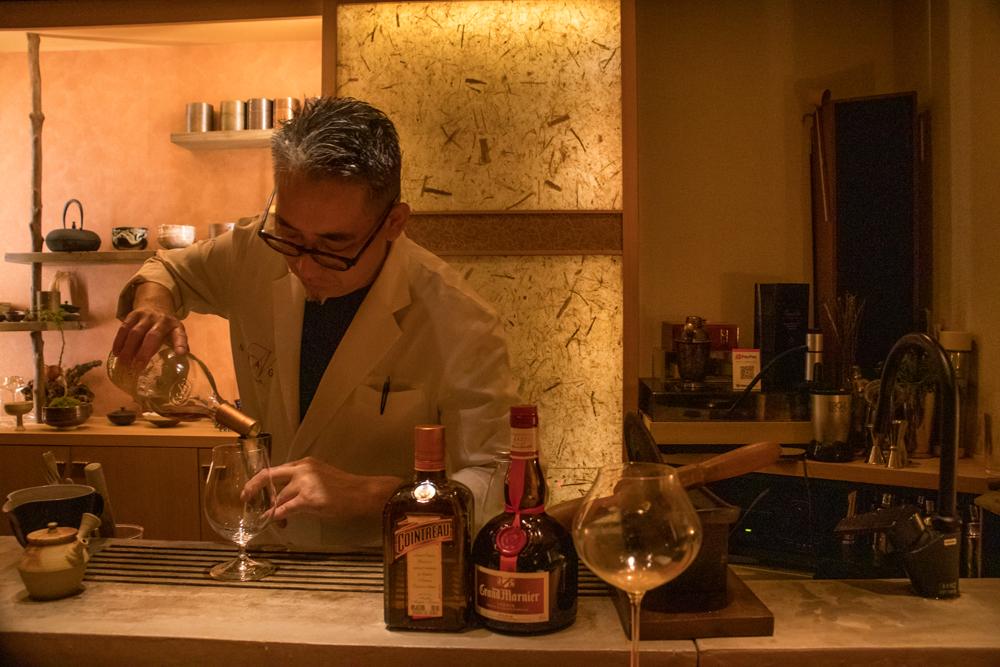
We spoke with Masamichi Itani, owner-bartender of NO’AGE concentré.
NO’AGE concentré: the vision behind the name
–Please tell us about NO’AGE concentré.
The “NO’AGE” in the bar’s name, NO’AGE concentré, comes from a term used to describe whisky. It means “to create a whisky full of character by blending whisky of various ages by means of excellent blending techniques.”
We are opening NO’AGE concentré with the desire to be “a store loved by customers of various generations,” as the term “NO’AGE” implies.

The name of the BAR, “NO’AGE concentré”, is purposely devoid of the word bar. This is because we want to create a unique offering in the style of a “saryo” (tea house) that serves not only alcohol and food, but also Tea Cocktails and Pairings, without being restricted to the label of a “bar.”
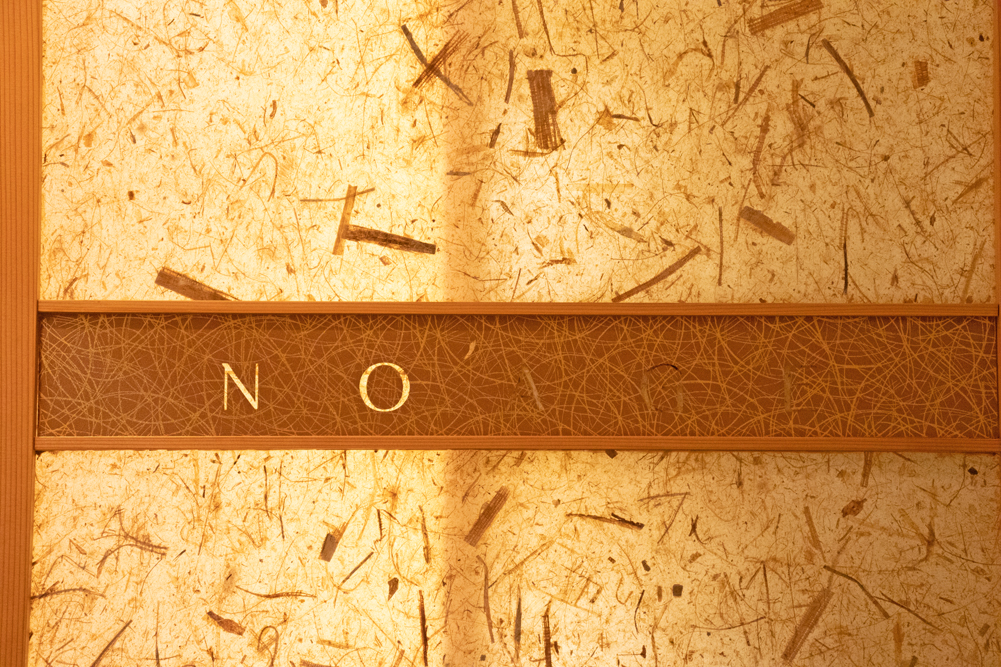
In fact, this is the third time this bar has been relocated. The first time we opened was in Fukuroi. After about 6 years of business there, I decided that I wanted to open my ideal bar in a location closer to the city center. I was torn between relocating to Tokyo or Shizuoka, but eventually decided to move to Shichiken-cho, Shizuoka. After that, I relocated to Takajo and here we are today.
Upon moving to this new location, we installed teppanyaki equipment (a Japanese griddle) for the first time. It has long been a dream of mine to offer teppanyaki cuisine paired with tea cocktails.
 ▲The teppanyaki griddle, newly installed upon relocation. This new equipment has enabled the restaurant to respond to customers’ requests more flexibly than ever before.
▲The teppanyaki griddle, newly installed upon relocation. This new equipment has enabled the restaurant to respond to customers’ requests more flexibly than ever before.
Sublime Japanese tea cocktails and pairings crafted by the Yokohama International Cocktail Competition Grand Prix winner.
(Itani won the Grand Prix in the creative category of the Yokohama International Cocktail Competition in 2016. His exceptional bartending skills are highly regarded and have been published in various cocktail and pairing books.
When he holds a shaker in his hand, he has the “movement” of a bartender; when he switches to tea utensils, he has the “stillness” of a tea master; and upon occasion he commands the spatula to make the flames dance with the “magic” of a chef. The way he freely mixes all of these elements in his every move is mesmerizing.)
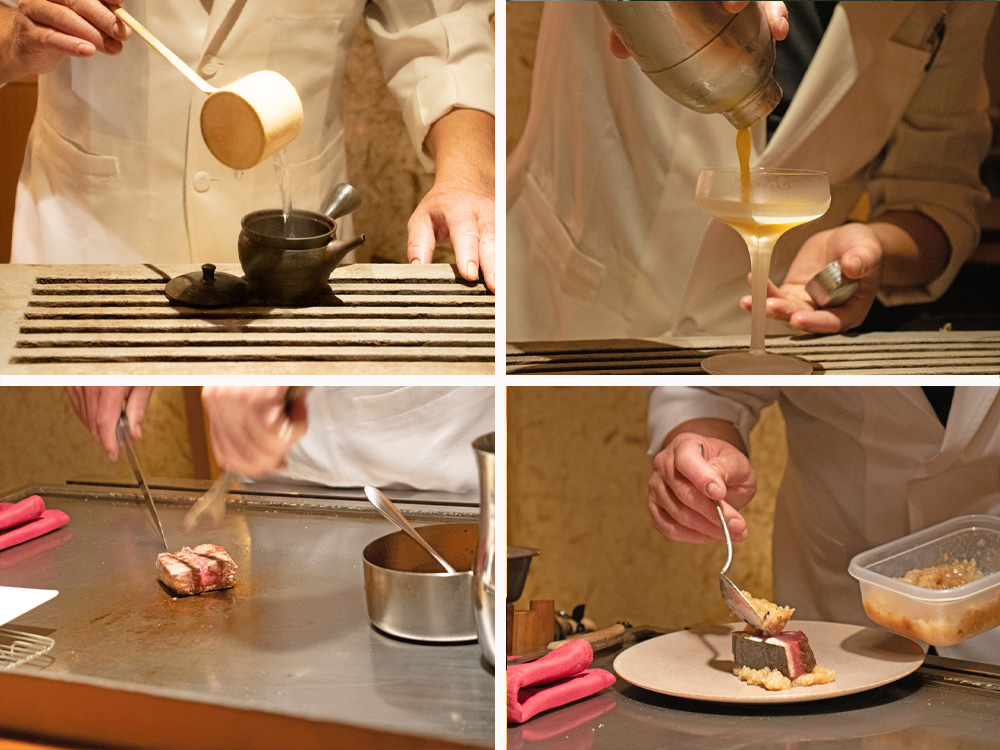 ▲While sipping the cocktail you ordered, sit and be captivated by the attractive cooking scenes being performed over the counter.
▲While sipping the cocktail you ordered, sit and be captivated by the attractive cooking scenes being performed over the counter.
–It is amazing that you are able to do everything from the food, cocktails, tea, and even the establishment of the concept of the restaurant. Do you have consultants on board?
Nope. (Laughs) However, it is true that there are not many people who can make delicious food and communicate it with their own unique world view. For me, bartending is a job that requires coordinating conversations, time, and space, so I take the initiative in doing it all myself.
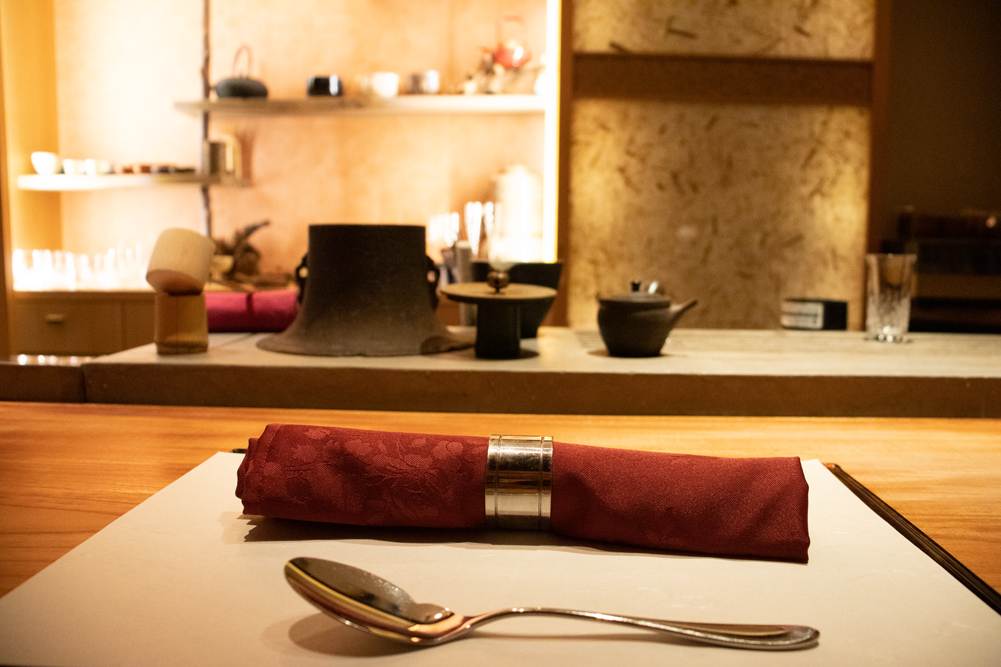
–Coordinating the space? So bartending is a job requiring a certain sensibility?
The Japanese word for a bartender is choshushi and is literally translated as “liquor chemist” derived from the Japanese word for “pharmacist.” It is used to describe a person whose job is to serve alcoholic beverages and drugs, which have historically been used as medicine in combination with food in a way that maximizes their appeal and efficacy.
In principle, we recommend tea-based cocktails, but are flexible to accommodate the customer’s preferences, including non-alcoholic cocktails.
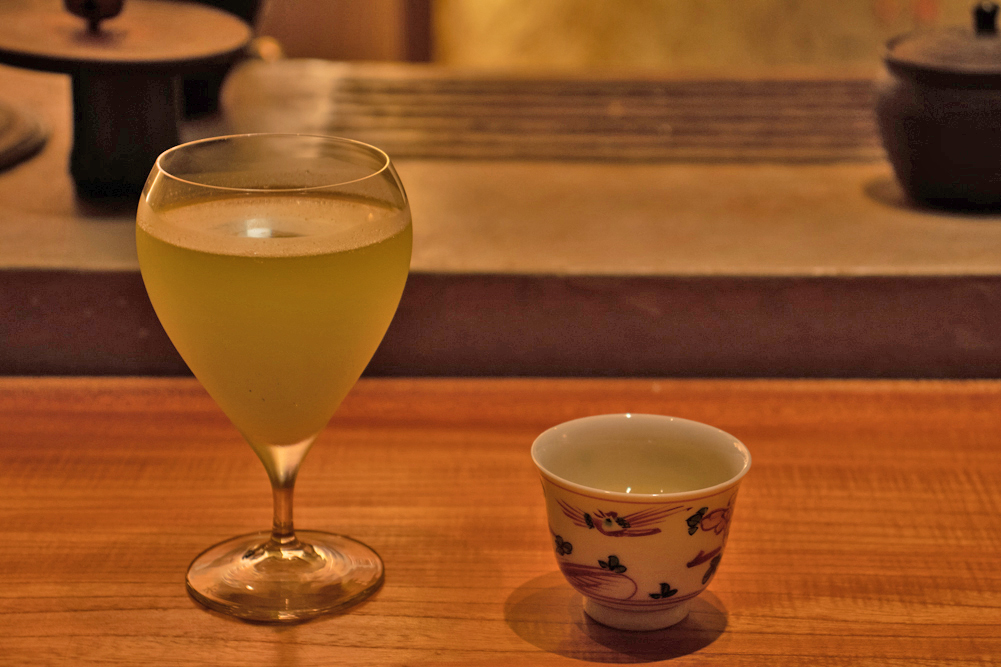 ▲ (Tea Cocktail Pairing) Kouju and Muscat Grape. A gorgeous tea cocktail in which kouju, a tea variety with a muscat grape-like aroma, is paired with a fruity liquor to harmonize and enhance each other’s delicious flavor.
▲ (Tea Cocktail Pairing) Kouju and Muscat Grape. A gorgeous tea cocktail in which kouju, a tea variety with a muscat grape-like aroma, is paired with a fruity liquor to harmonize and enhance each other’s delicious flavor.
–The taste and aroma are unlike anything I have ever tasted before. I am sure people in the tea industry were surprised! Have you felt that?
There have a variety of reactions from people. Tea has a long history from before the Edo period. New approaches in such traditional areas are not always welcomed. Some customers say, “Why not just serve regular tea instead of tea cocktails?
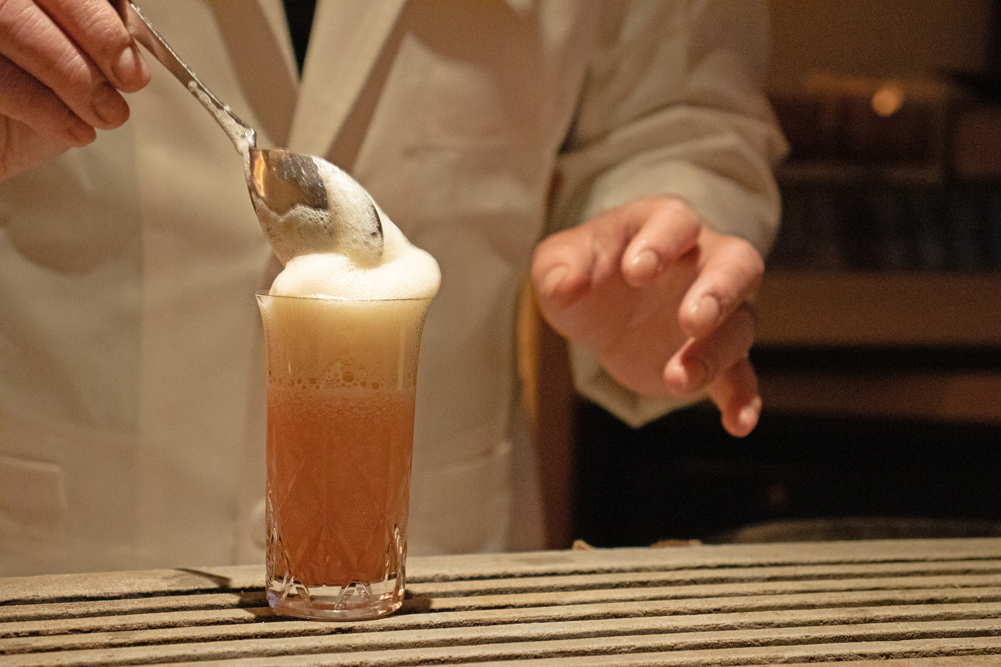
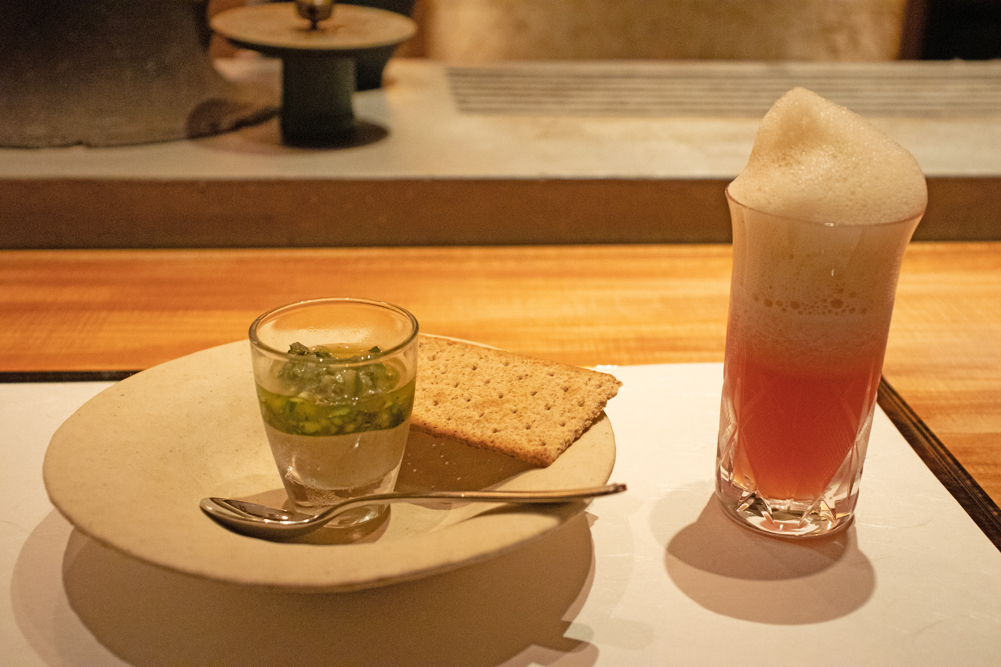 ▲Pairing Menu – Ayu Fish Pâté with Cucumber and Mint x Watermelon and Oolong
▲Pairing Menu – Ayu Fish Pâté with Cucumber and Mint x Watermelon and Oolong
On the other hand, customers from overseas have told me “Wow! This is new!” My personal view is that hospitality should be allowed expression in a variety of ways. If Sen no Rikyu were alive today, I am sure he would have provided omotenashi (hospitality) in diverse ways, and he might even have used sake to brew tea.
–I see. Perhaps ancient literature mentions such things. (Laughs)
I think it would be good to have more free expressions of tea without being too conservative. However there is a conservative trend not only in tea but also in the world of whisky.
–It’s the same in the world of whisky?
Yes, of course. Don’t forget, I’m originally a professional in the world of whisky.
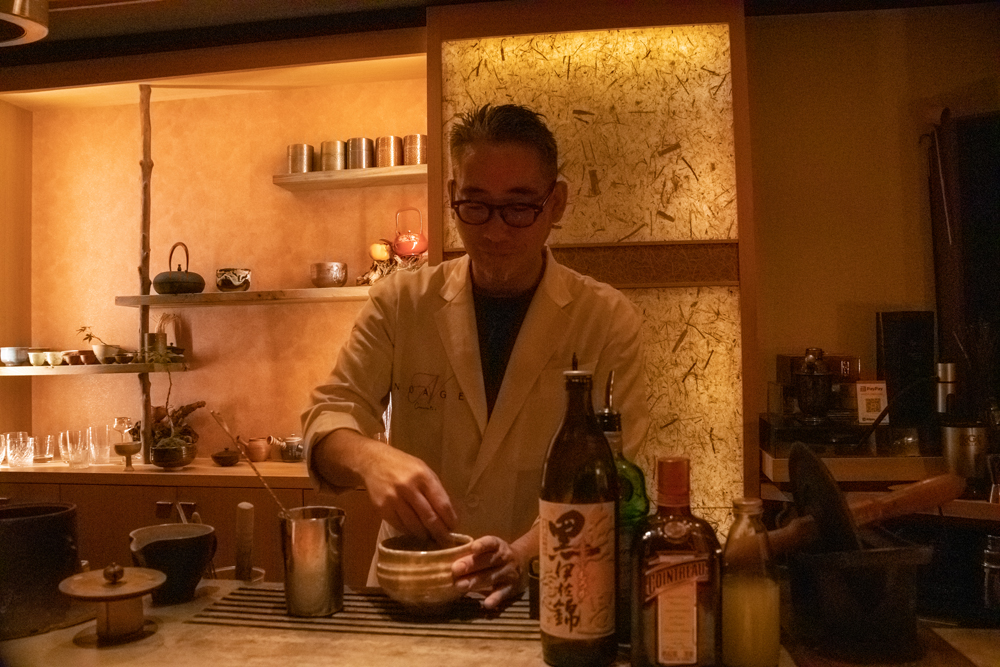
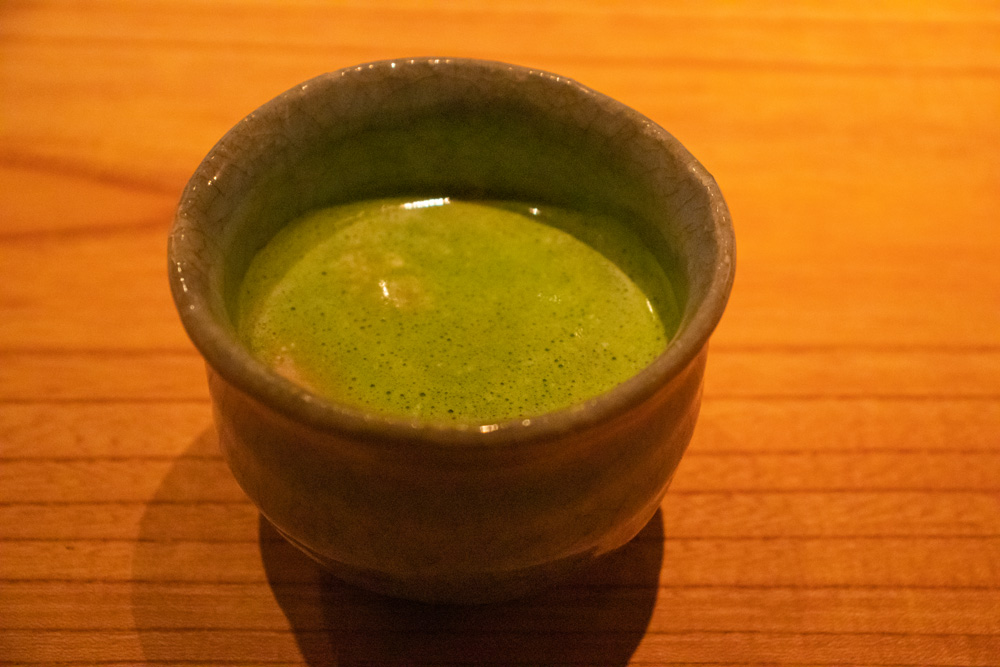 ▲The bartender prepares matcha and transforms it into a cocktail. A rare tea cocktail experience.
▲The bartender prepares matcha and transforms it into a cocktail. A rare tea cocktail experience.
The background to his entry into the world of tea; skills and experience accumulated from his career as a bartender.
I worked professionally in the whisky world until a couple of years ago. The whisky world has become a very exciting place thanks to many friends and fans. I am sure that the trend will continue to grow, however, I felt that I had already fulfilled my role as a bartender.
The world of tea, on the other hand, is in a very difficult situation. I believe that now is the time to take action. I think someone needs to reach out and offer a helping hand.
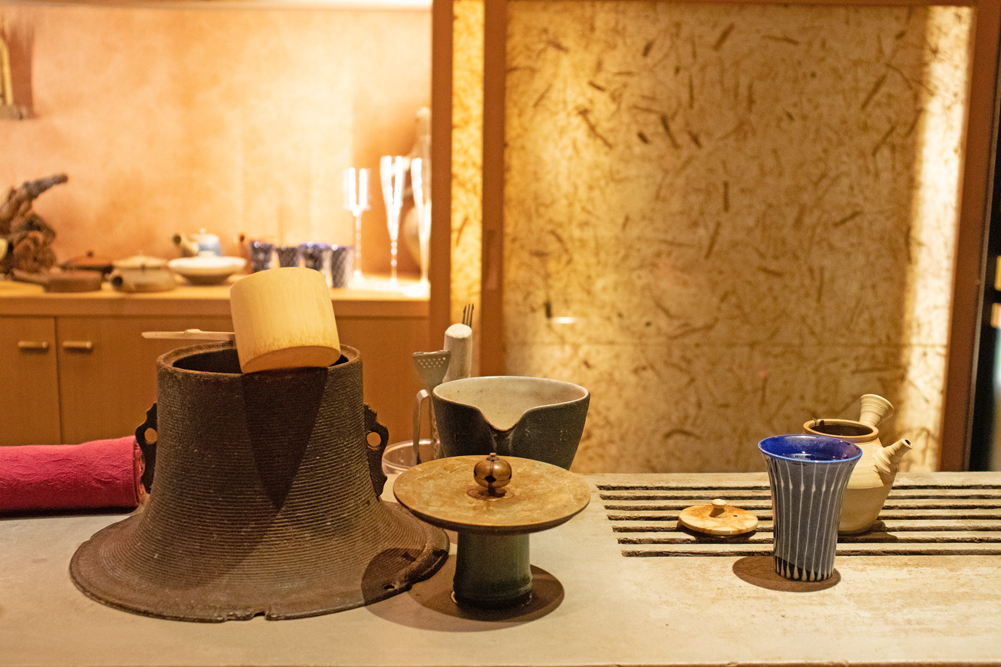
–So you decided to try your hand at tea next.
I would like to use the skills and experience I have cultivated to draw out the apeal of tea and present it to customers in my own unique approach. My goal is to increase the number of people who enjoy tea. I find it very rewarding to do so. It may be a meagre contribution, but I would like to be a force for the tea industry by doing what I can.
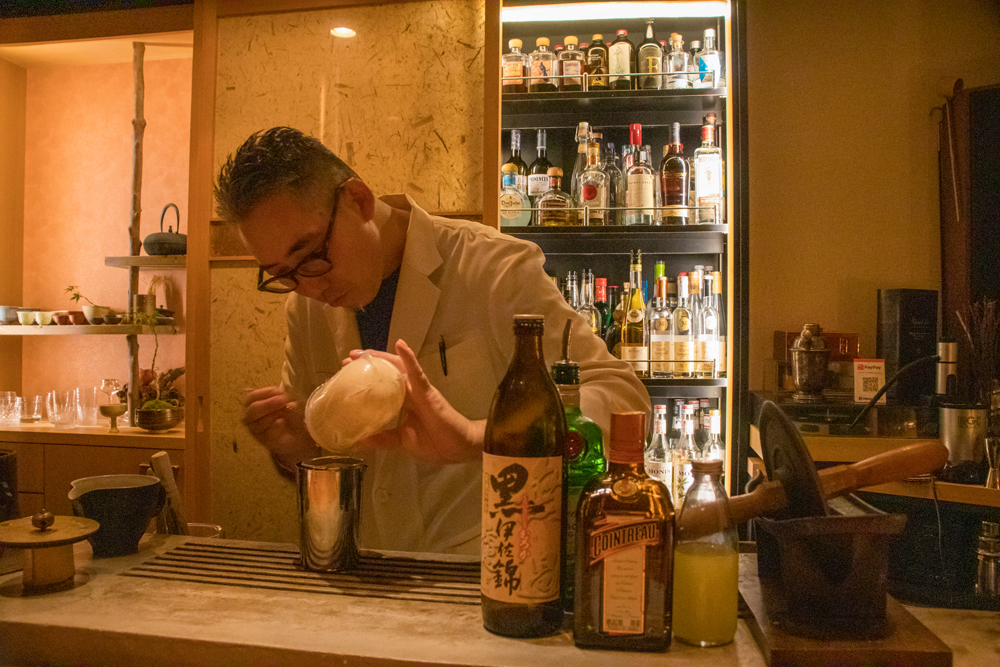
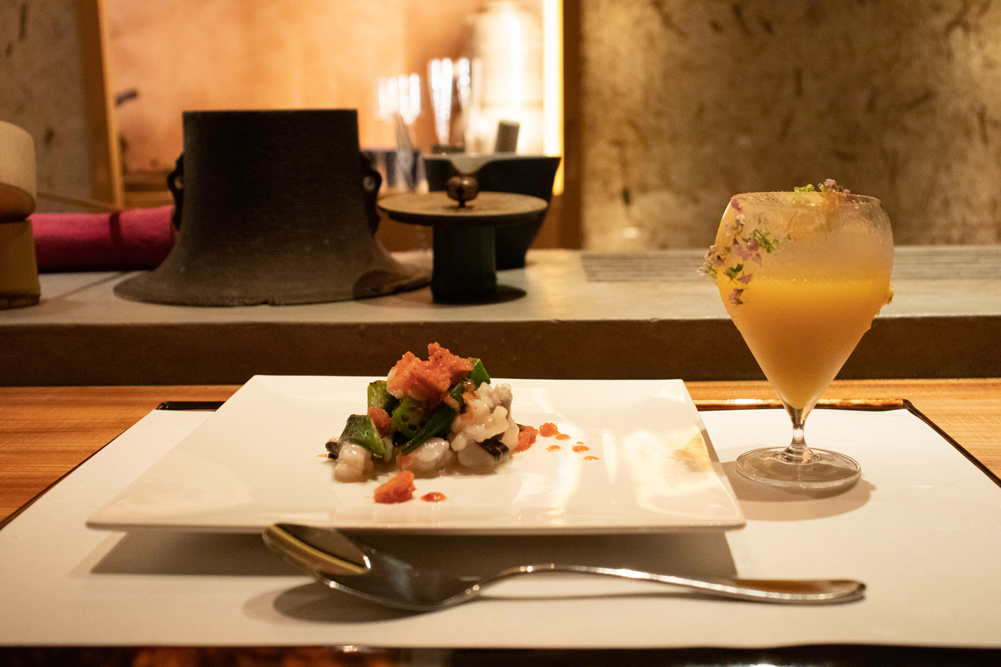 ▲(Pairing Menu) Hamo eel and plum salad x Peach and aromatic green tea, sansho (Japanese pepper) and sudachi (citrus fruit)
▲(Pairing Menu) Hamo eel and plum salad x Peach and aromatic green tea, sansho (Japanese pepper) and sudachi (citrus fruit)
Concept: A bar providing a luxurious experience to rival those of Kyoto and Tokyo.
–Please tell us, as you had mentioned at the beginning, what is your idea of an ideal bar
My ideal bar is a “valuable and luxurious space” in Shizuoka that is as good as the best places one may find in Kyoto or Tokyo. I want to create a place that people will come to enjoy a special atmosphere.
–Certainly, when you are in this Bar, it feels as if you are not in Shizuoka at all. The atmosphere is very quiet and calm.
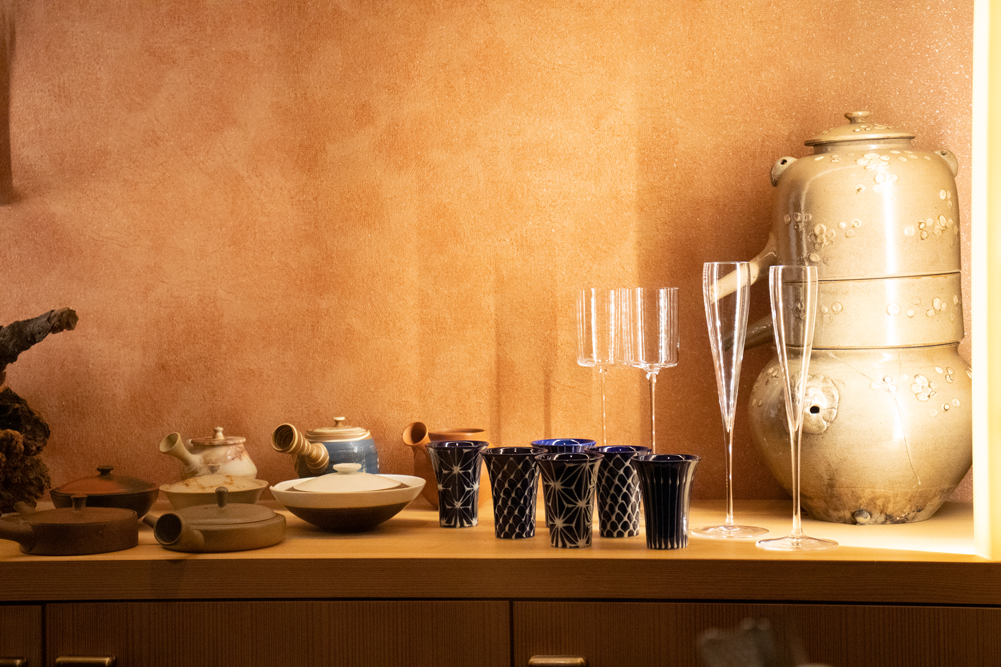
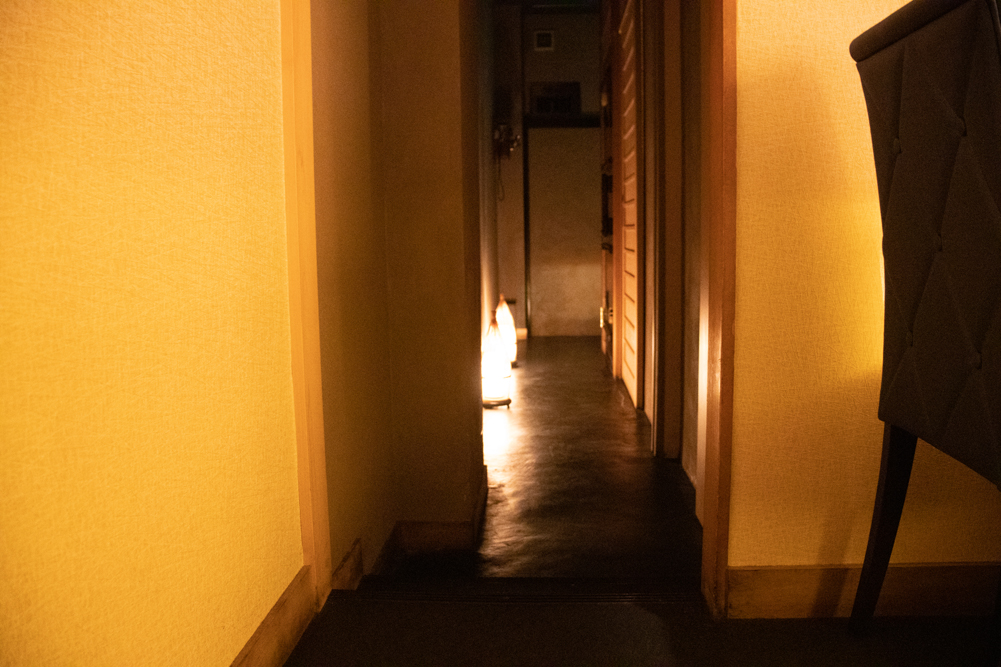
Look, I’m not saying that I just want everyone to be quiet. (Laughs) However, the fact is, a bar is not a place to talk loudly, but a place to spend time peacefully.
As an adult, one is able to care and think of others around them without thinking only of themselves. I believe that a bar is a place where such people come to gather.

Sometimes people say that I have very high standards, and there have been times when I have suffered from a lack of customers. In the end, I feel that in aiming for my goal, I have to be prepared to accept that some people will not understand it.
I believe that we have made it this far thanks in part to the support and encouragement of many fellow bar owners.

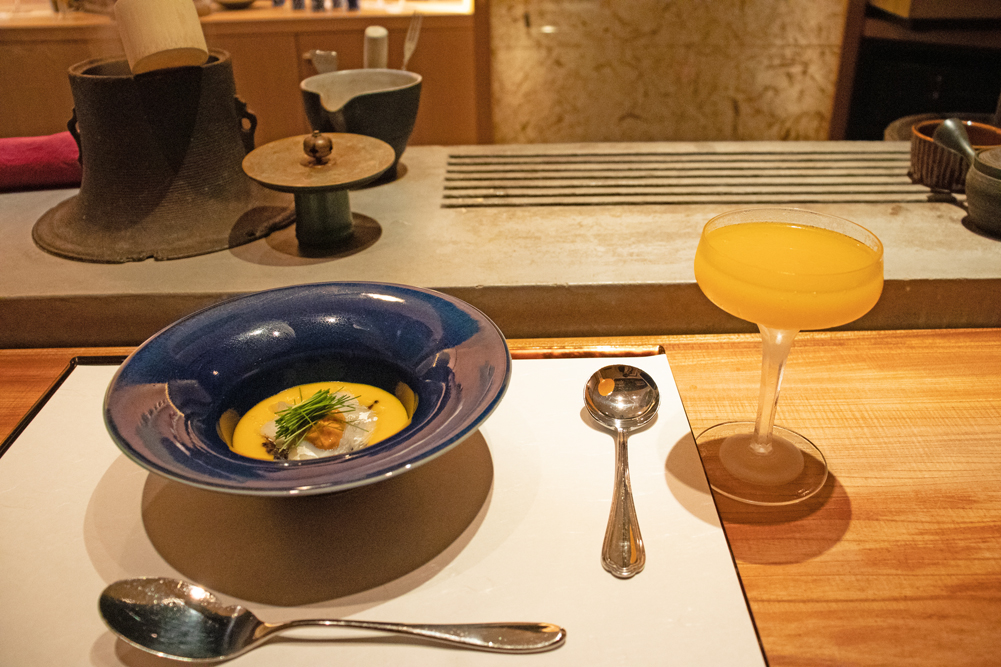 ▲(Pairing menu) Black rice risotto with flathead and sea urchin, pumpkin purée and mimolette x 3-year bancha tea with mango, mango vinegar and orange peel
▲(Pairing menu) Black rice risotto with flathead and sea urchin, pumpkin purée and mimolette x 3-year bancha tea with mango, mango vinegar and orange peel
–I’m sure you went through a lot of hardships to get the bar to this point. Is there anything that you have come to value in the process?
What I feel has been important in my career as a bartender is to maintain a balance between my perspective as an artist and that of a designer.
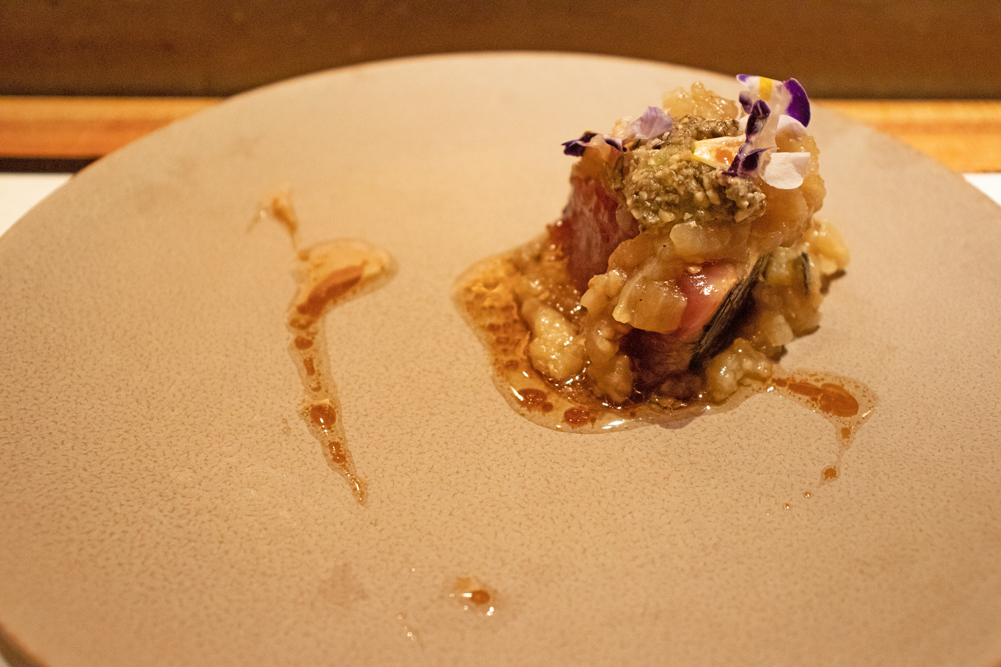
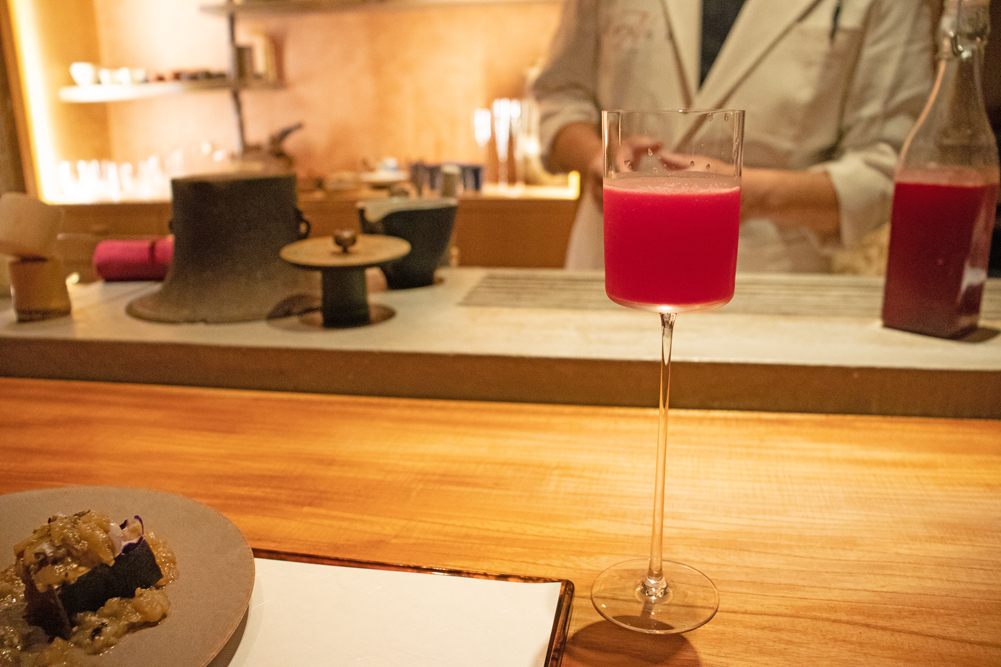 ▲(Pairing menu) Bonito and grilled aubergine × Awa Bancha, fermented beetroot and coconut oil
▲(Pairing menu) Bonito and grilled aubergine × Awa Bancha, fermented beetroot and coconut oil
Bartender Masamichi Itani’s perspective – the point where a designer’s role and artist’s sensibility intersect.
An artist’s perspective is necessary for creative uniqueness. However, if you respond to requests exclusively from the point of view of an artist, you will appear to be self-absorbed.
Design is something that is created for the client. Therefore, designers must work from the standpoint of the user, the client, and the customer.
The important thing is to maintain both perspectives. In other words, “to be both an artist and a designer.” That is what I keep in mind.
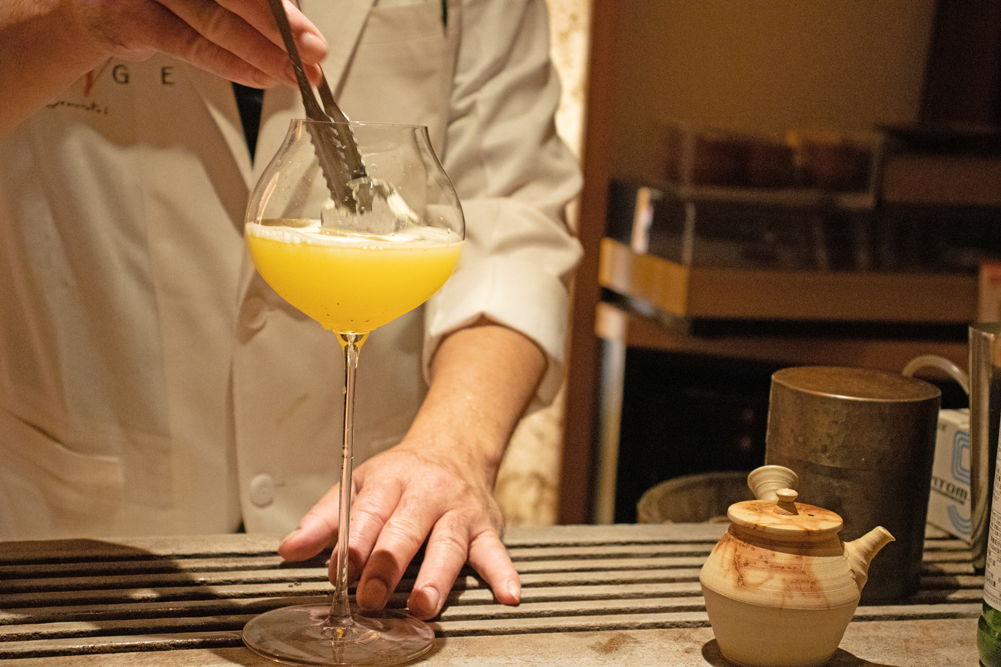
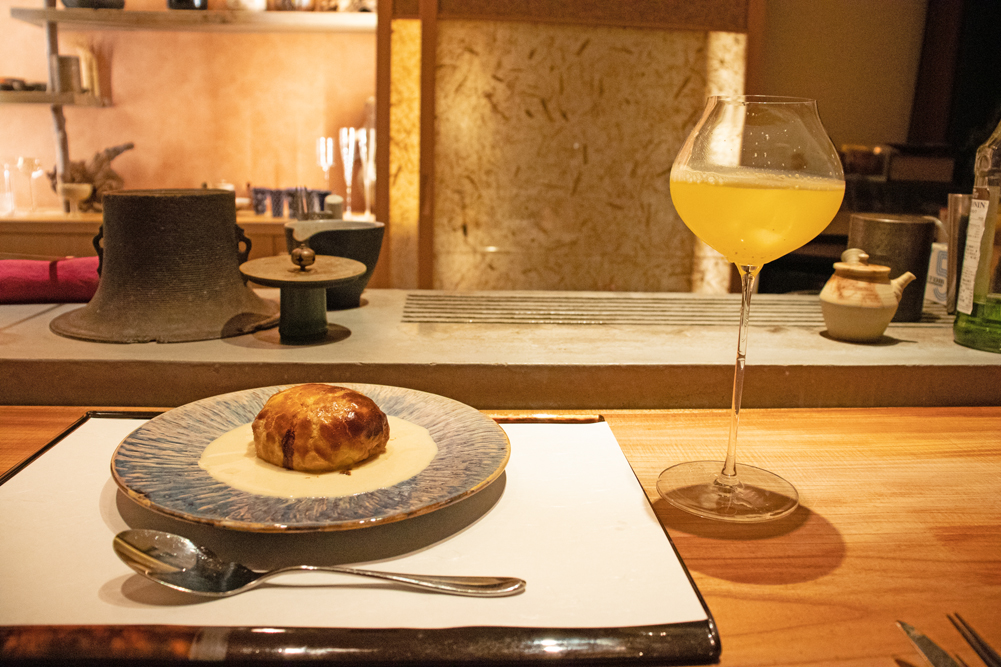 ▲(Pairing Menu) Sea Bass Pie with Saffron Cream Sauce × White Tea with Passion Fruit and Lemon Verbena
▲(Pairing Menu) Sea Bass Pie with Saffron Cream Sauce × White Tea with Passion Fruit and Lemon Verbena
When I look back at my life as a bartender, I realize that I used to allow the artist part of me to take over. I may have been somewhat self-absorbed.
Once I began to realize this, the need to have more of a designer’s perspective, the way I thought about and approached cocktails changed. The taste of my cocktails changed dramatically. It was right around the time I started experimenting with tea.
These days, I continue to be creative, but at the same time focus on making cocktails that my customers will drink and enjoy.
–I see that you value what you want to create, but at the same time, make a point of being attentive to your customers.
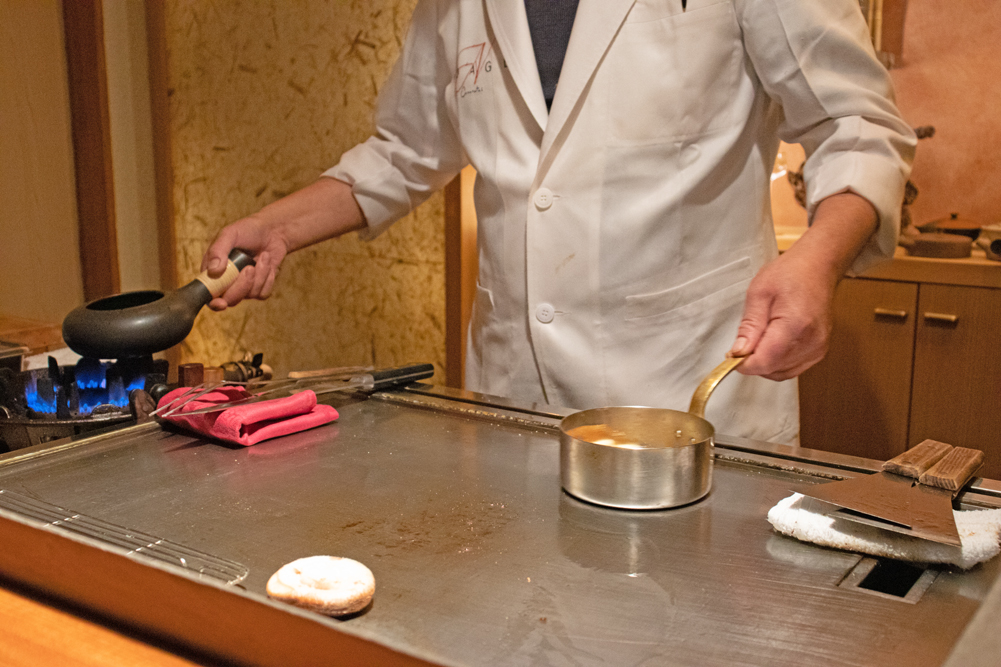
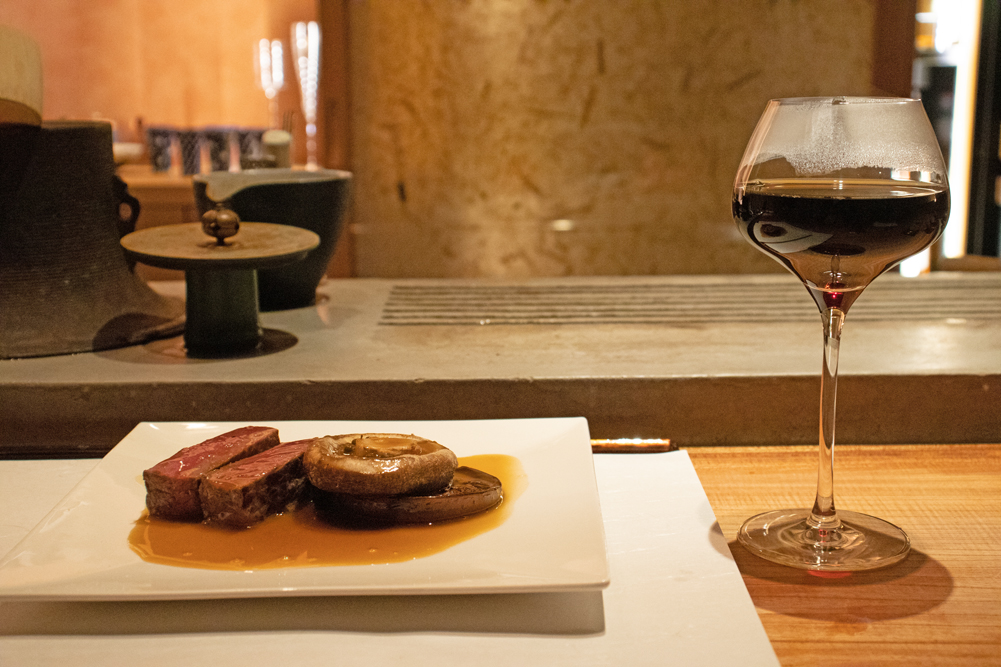 ▲(Pairing Menu) Beef Rump Roti with Butter Soy Sauce Japanese Pepper style × Three Year Hojicha with Charred Kombu
▲(Pairing Menu) Beef Rump Roti with Butter Soy Sauce Japanese Pepper style × Three Year Hojicha with Charred Kombu
Japanese Tea Cocktails and Pairings on theme of Japanese Seasonal Beauty~Kachō fūgetsu~
Shizuoka is a wide prefecture, with varying land characteristics in the north, east, south and west. Each region has its own unique terroir, and the flavor of its tea and foods clearly express the character of the land. It is a lot of fun thinking of combinations that capitalize on the charms of each of these areas. (Laughs)
This is my “Sakura Shrimp and Campari Negroni.” This cocktail is made by marinating dried sakura shrimps in Campari and mixing it with japanese sake and grange. It is also available as a stand-alone item, but originally this cocktail was developed to accompany the pairing course meal.
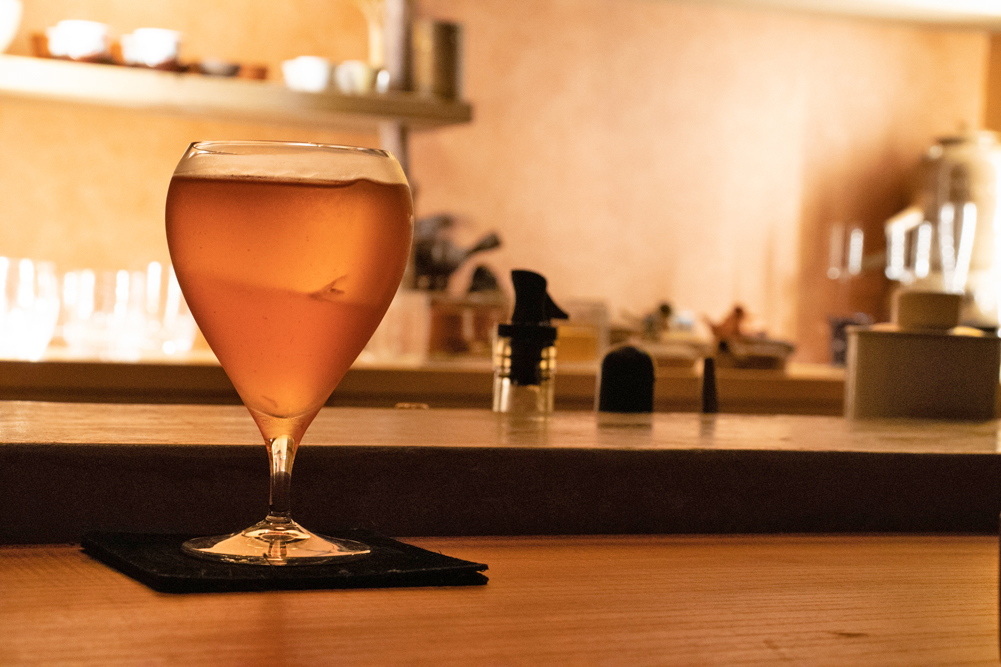 ▲A beautiful cocktail with the cherry blossom colours of sakura shrimps. The flavour of the sakura shrimps combined with the bitterness of Campari creates a profound, addictive taste.
▲A beautiful cocktail with the cherry blossom colours of sakura shrimps. The flavour of the sakura shrimps combined with the bitterness of Campari creates a profound, addictive taste.
The pairing of ‘Sakura Shrimp and Campari Negroni’ and ‘Poached Golden Eye Snapper’, known as the ‘Suruga Bay Pairing’, has been very well received by many diners. However, this pairing is not available all year round. It is a seasonal menu item only available during the sakura shrimp fishing season.
–I understand that sakura shrimp are seasonal, but golden eye snapper is available all year round. Why is it limited to a certain period of time?
Because I think that it’s better that way. (Laughs) I want to treat the seasonal rhythms that are characteristic of Shizuoka with care. Applying my techniques to make use of seasonal ingredients is something I have valued since the shop’s beginnings in Fukuroi.
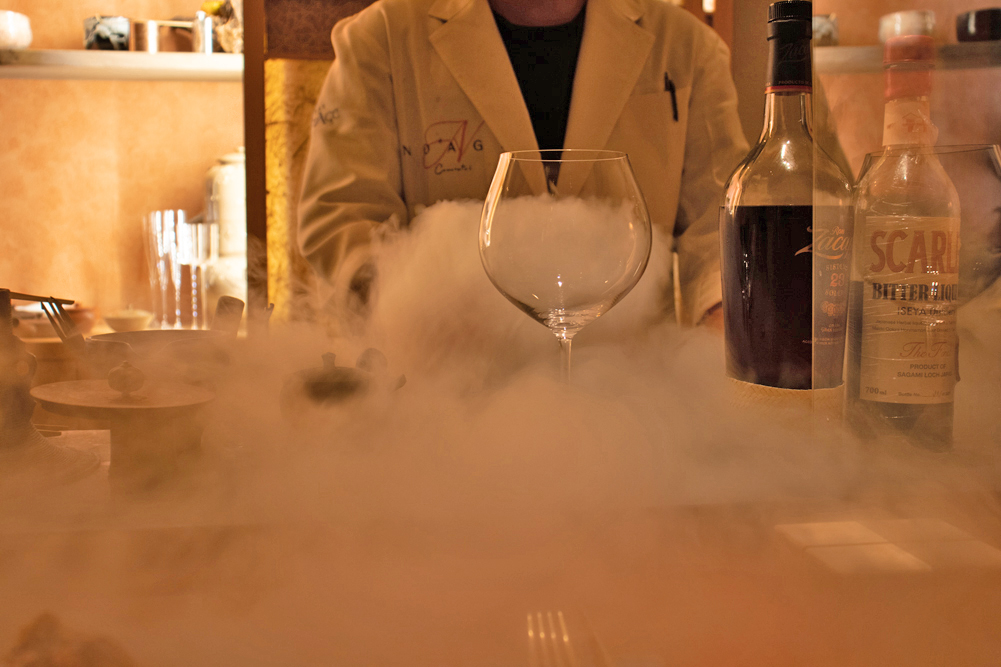
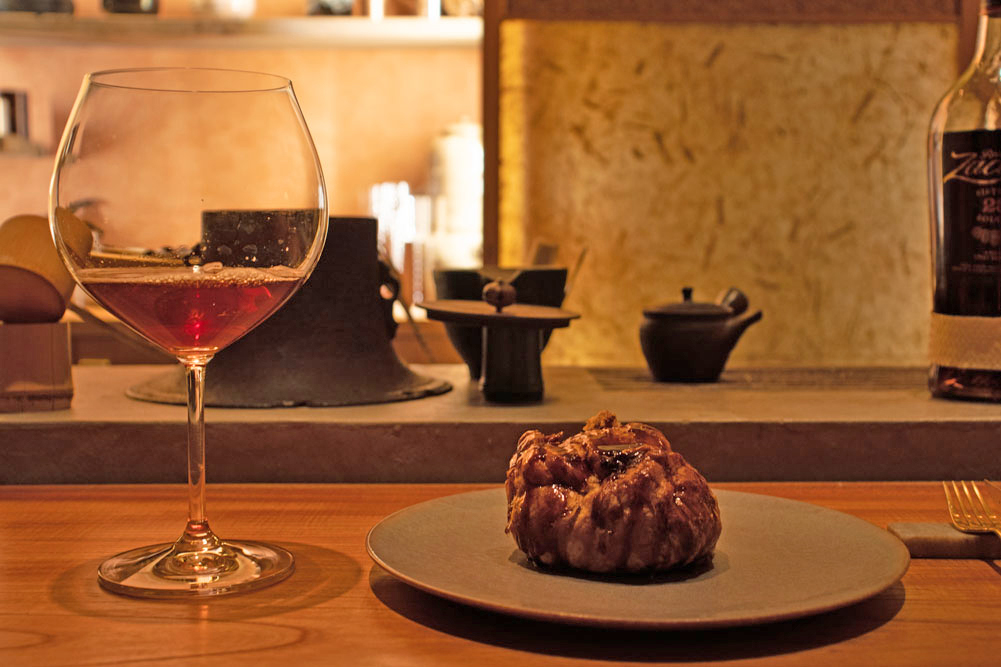 ▲Hojicha Armagnac x Seasonal Sweets
▲Hojicha Armagnac x Seasonal Sweets
I want to create delicacies that evoke images of seasonal landscapes in peoples’ minds by drawing out and harmonising the charms of regional ingredients. In cocktails, as in cooking, we place importance on the seasons and seasonal elements. I think this is a concept that is also shared with the world of tea ceremony and tea.
–Completely. They are “Pairings on Kachō fūgetsu (the Japanese word used to describe the beauties of nature commonly expressed in traditional Japanese art and culture) the theme of Japanese Seasonal Beauty.”
Kachō fūgetsu is a favourite phrase of mine. Through cocktails, food and tea, I want to create precious moments of interaction between people overflowing with emotion. I would be happy if even just one person could rediscover tea as enjoyable and delicious.
Recommended articles : The quintessential Shizuoka experience at Omatcha-Kondo-no-Shokudo Restaurant 【Shizuoka City, Shizuoka Prefecture】
Recommended articles : Discover 5 Recommended Destinations for a Gourmet Lunch and the finest Japanese Green Tea!【Shizuoka Prefecture】
Information of NO’AGE concentré
| Address | 2-5-12 1F, Takajo, Aoi ku, Shizuoka City, Shizuoka Prefecture, 420-0823, Japan |
| Website | https://www.barnoage.com/(jp only) |
| Phone number | +81 54-253-6615 |
| E-money and credit cards | Credit cards and Partially e-money available |
| Open | Open Varies depending on the time of year. As of 2023, lunch and dinner are by reservation only; BAR TIME is every Friday and Saturday from 21:00 to 24:00. BAR TIME can be entered without a reservation. Details are announced on social networks and on the website. |
| Closed | non-scheduled holiday |
| Parking lot | Pay parking available nearby. |
| Access | 15 minutes walk from Shizuoka Station. |
| Writer | Norikazu Iwamoto |
| Career | Ochatimes chief editer. Meeting with Vice Governor of Shizuoka prefecture. Judge of Shizuoka 100 tea’s award in 2021~23. Ocha Times link introduced at website of World O-CHA(Tea) Festival 2022, Tea Science Center, The City of Green Tea Shizuoka, Ministry of Agriculture, Forestry and Fisheries. |
| English translator | Calfo Joshua |
| Career | Born and raised in England, living in Japan since 2016. Studying arboriculture in Shizuoka Prefecture whilst operating his landscape business Calfo Forestry. Appreciating the nature of Japan and the culture that places such importance in it. |


 Go to Japanese page
Go to Japanese page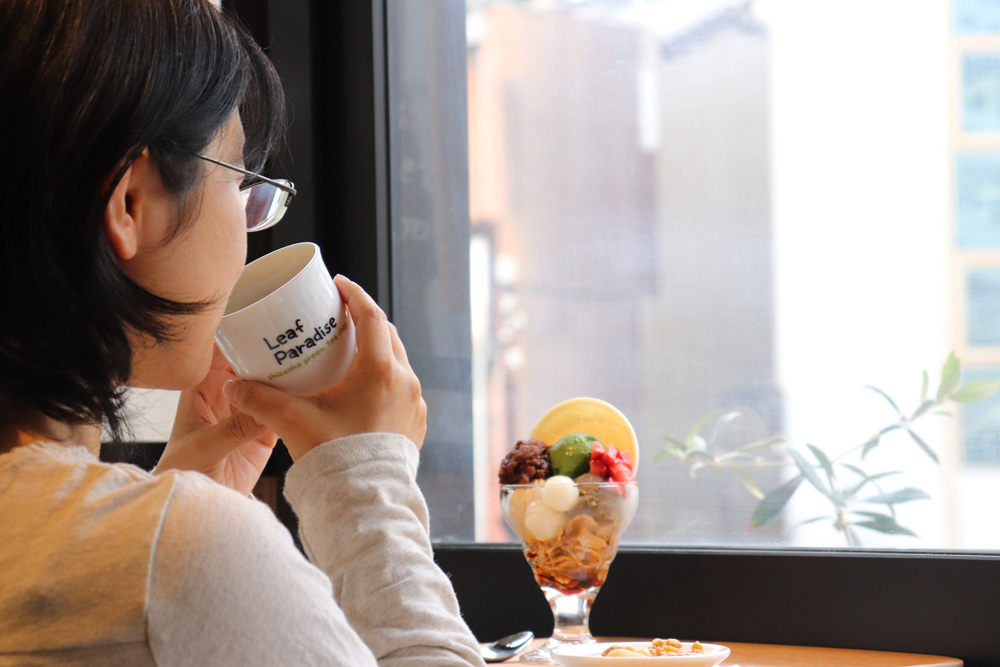
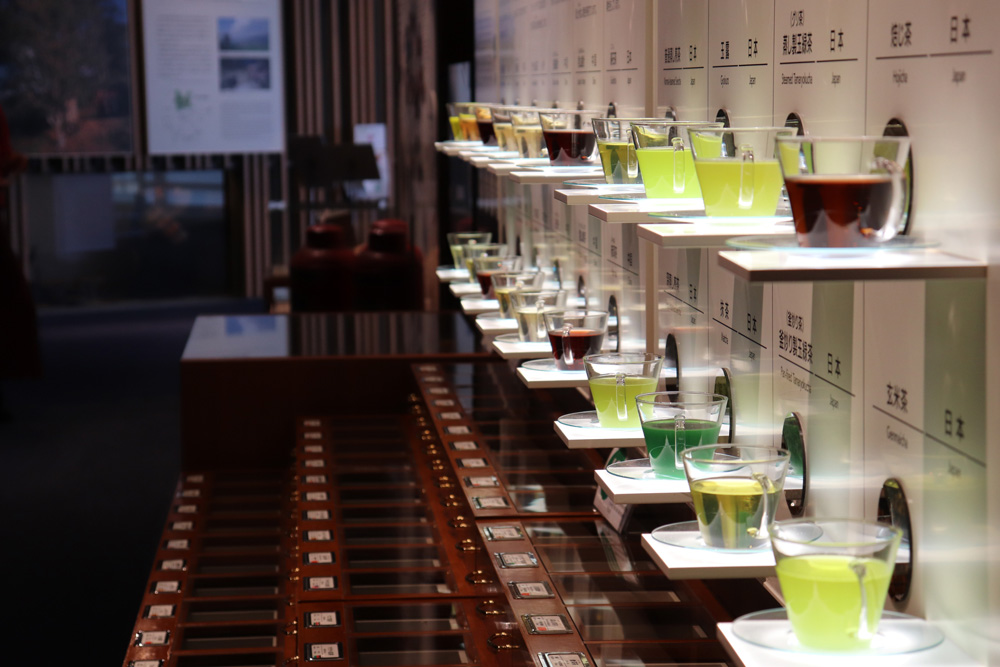
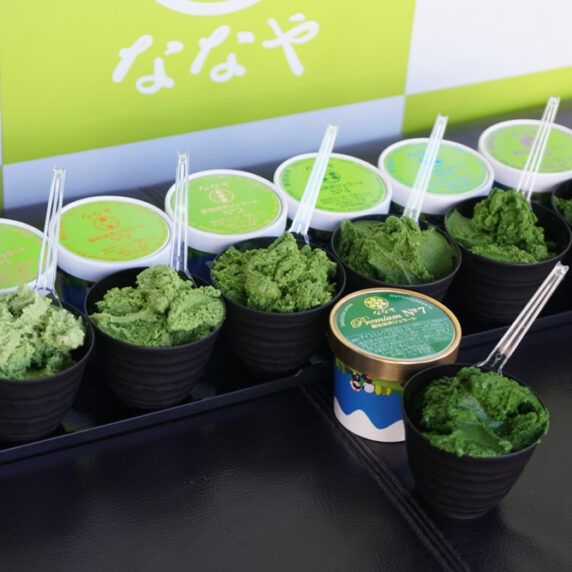
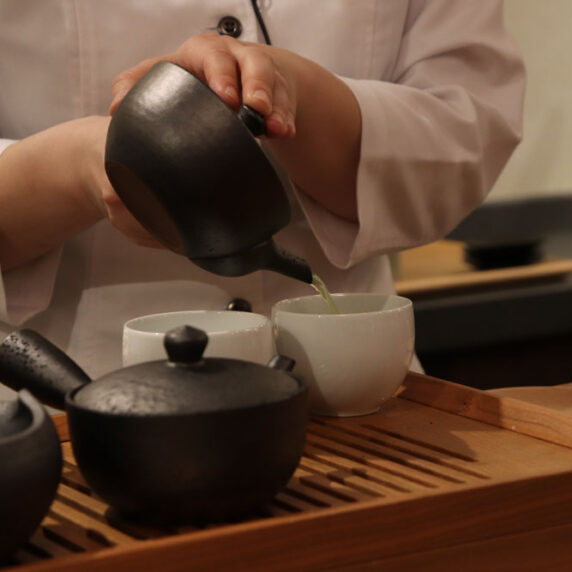
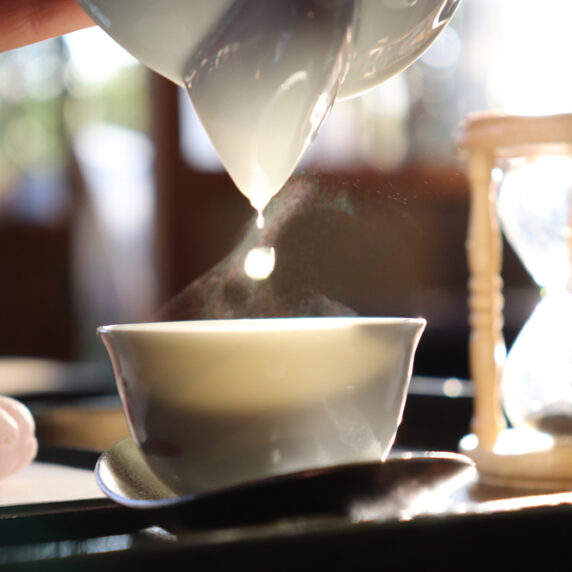
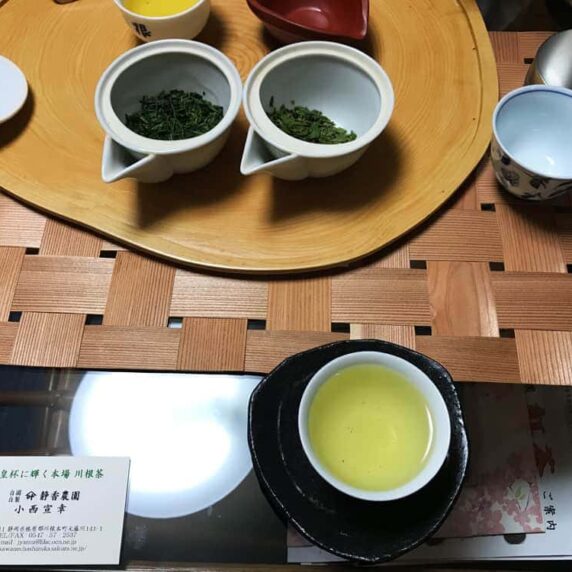
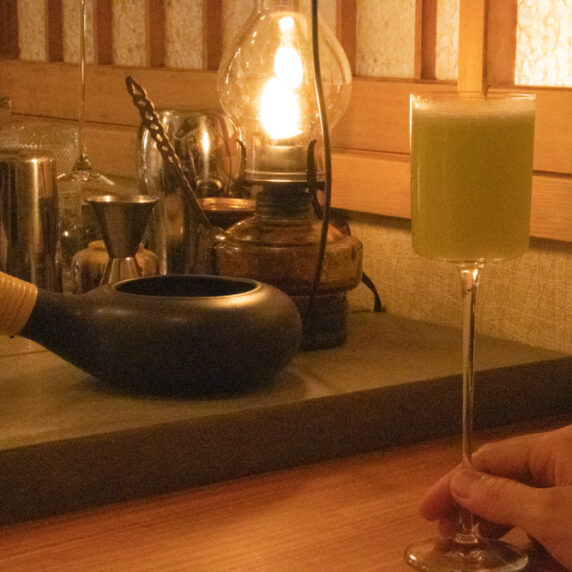




 on the red bar to close the slide.
on the red bar to close the slide. to see the distance between the current location to the Chaya.
to see the distance between the current location to the Chaya.